Chapter VI: The Virgin Mary, the humble servant of the Lord
- Entire (2.99 Mo)
- Part 1 (2.5 Mo)
- Part 2 (353 Ko)
- Part 3 (239 Ko)
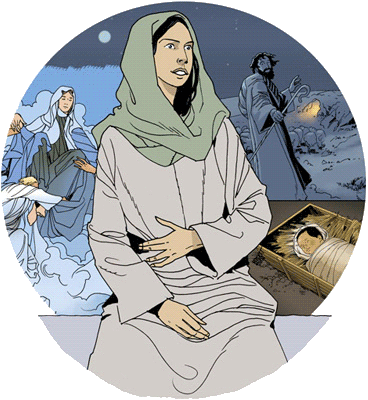 It is no coincidence that the name of Jesus is included in the title of this chapter devoted to the Virgin Mary. Truly we see that the Virgin Mary is inseparable from her divine Son. We will discover the three fundamental components of Mariology: Mary's unique mission as Mother of the Word (theVerb made flesh), living bread descended from heaven for the salvation of man; Mary's unique privileges – the Virginal Ark, more precious than that which contained the manna and the stone tablets of the covenant ; lastly the worship or exceptional veneration owed to this Ark.
It is no coincidence that the name of Jesus is included in the title of this chapter devoted to the Virgin Mary. Truly we see that the Virgin Mary is inseparable from her divine Son. We will discover the three fundamental components of Mariology: Mary's unique mission as Mother of the Word (theVerb made flesh), living bread descended from heaven for the salvation of man; Mary's unique privileges – the Virginal Ark, more precious than that which contained the manna and the stone tablets of the covenant ; lastly the worship or exceptional veneration owed to this Ark.
- 0
THE WOMAN CROWNED WITH STARS
- A bright light will shine to all parts of the earth;
- many nations shall come to you from afar,
- And the inhabitants of all the limits of the earth, drawn to you by the name of the Lord God, bearing in their hands their gifts for the King of heaven.
- Every generation shall give joyful praise to you, and shall call you the chosen one, through all ages forever.
- Accursed are all who speak a harsh word against you;
- accursed are all who destroy you and pull down your walls,
- And all who overthrow your towers
- and set fire to your homes;
- but forever blessed are all those who build you up.
- Go, then, rejoice over the children of the righteous,
- who shall all be gathered together
- and shall bless the Lord of the ages.
- Happy are those who love you!
- Happy those who rejoice in your prosperity!
- Happy are all the men who shall grieve over you,
- over all your chastisements,
- For they shall rejoice in you
- as they behold all your joy forever
- Tb 13:11-14
This “canticle” from Tobit seemed directed to the city of Jerusalem. In reality, it is directed to the new heavenly Jerusalem which begins in Mary, the Mother of Jesus. Mary, the new tabernacle, the Holy of holies, the star which leads to the Almighty those gone astray, the Co-redeemer who, for centuries to come, rejoices in being Mother of the redeemed. It is the true canticle of the Co-redeemer.
He who wants to listen to and follow the Gospel must take seriously, as much as the rest of the Gospel, the numerous scenes where Mary appears. And he must really want to bring the scattered stones of the mosaic together so as to see the whole shining picture of Mary, of her person and her function. But the picture which appears in such a global vision is not just about her, it refers constantly and in every way to Christ and to the Church. It shows that any Marian devotion, if it wants to be Catholic, must never be isolated, but must be part of and oriented Christologically (and so in the Trinity), as well as ecclesiologically. Saint John marvelously indicated this process when, in his Gospel, he never names Mary by her proper name.
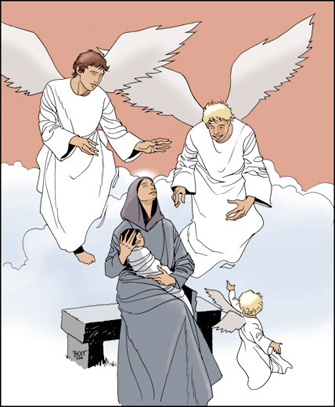 She is called “the Mother of Jesus”. She has, so to speak, abandoned what is personal so as to be totally at the disposition of Jesus. * Cardinal Joseph Ratzinger, Hans Urs Von Balthasar (for this as well as for the last paragraph of this chapter entitled « Let us testify to the Virgin Mary an ardent love »), Mary First Church, Médiaspaul & Pauline Editions, 1987, p. 62 and 13. Nota : as these are extracts, some changes from the original text have been necessary in order to fit them harmoniously in the chapter as a whole. This remark applies equally to the other references indicated in this chapter and as such will not be repeated. We are now going to bring together the mosaic’s scattered stones, beginning, however, by several passages in the Old Testament and ending with the Virgin’s Assumption.
She is called “the Mother of Jesus”. She has, so to speak, abandoned what is personal so as to be totally at the disposition of Jesus. * Cardinal Joseph Ratzinger, Hans Urs Von Balthasar (for this as well as for the last paragraph of this chapter entitled « Let us testify to the Virgin Mary an ardent love »), Mary First Church, Médiaspaul & Pauline Editions, 1987, p. 62 and 13. Nota : as these are extracts, some changes from the original text have been necessary in order to fit them harmoniously in the chapter as a whole. This remark applies equally to the other references indicated in this chapter and as such will not be repeated. We are now going to bring together the mosaic’s scattered stones, beginning, however, by several passages in the Old Testament and ending with the Virgin’s Assumption.
The woman of the Protoevangelium
Mary was announced by God in what is called the Protoevangelium. This announcement was made directly after our first parents’ fall. The Creator addresses the infernal serpent in these terms: “I will put enmity between you and the woman, and between your offspring and hers: He will strike at your head, while you strike at his heel” (Gen 3:15). We might imagine that the enmity in question is between the snake and the whole female population. Yet, this is disproved in the following text where the gender itself changes: “He will strike at your head” and not “She will strike at your head.” The text announces already the future Savior, Jesus. Because of this Savior’s birth by a “woman”, there will be enmity between the snake and “this woman.” The woman in question is Mary, the Savior’s Mother. Therefore, along with the Messiah, his mother is implicated. We read in Saint Paul’s Epistle to the Romans: “For just as through the disobedience of one person (Adam) the many were made sinners, so through the obedience of one (Jesus Christ) the many will be made righteous” (Rm 5:19). It would not be too much to add to this text: since evil came into the world by a woman (Eve), it is right that by the Woman (Mary) goodness reenter into the world. And we know now how she will do it: by absolute obedience. Absolute purity. Absolute humility. For great is she who does God’s will. That is why Mary is great.
Isaiah’s prophecy on the Virgin Mary of Emmanuel
Therefore the Lord himself will give you this sign:
the virgin shall be with child, and bear a son, and shall name him Emmanuel. (Is 7:14).
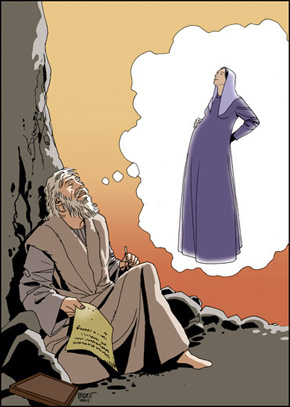 Instead of “young woman”, the Greek translation means “virgin”, thus specifying the Hebrew (‘almah) which can mean either girl or recently married young woman, not being specific as to which. But the text of the Greek version of the Septuagint is a precious testimony of the ancient Jewish interpreta-tion which is consecrated by the Gospel of Matthew: "Behold, the virgin shall be with child and bear a son, and they shall name him Emmanuel," which means "God is with us." (Mt 1 :23).
Instead of “young woman”, the Greek translation means “virgin”, thus specifying the Hebrew (‘almah) which can mean either girl or recently married young woman, not being specific as to which. But the text of the Greek version of the Septuagint is a precious testimony of the ancient Jewish interpreta-tion which is consecrated by the Gospel of Matthew: "Behold, the virgin shall be with child and bear a son, and they shall name him Emmanuel," which means "God is with us." (Mt 1 :23).
Isaiah’s prophecy on the root of Jesse
A shoot will spring from the stock of Jesse,
a new shoot will grow from his roots (Is 11 :1).
This messianic poem specifies certain essential traits of the Messiah to come, notably that he is from Davidic stock, (David being the son of Jesse). This stem which comes from the stock of Jesse is none other than Mary. Let us take advantage of this passage to stop a moment and consider the two genealogies of Christ that we find in the Gospels, one from the Gospel of Matthew * Mt 1 :1-17 et Lc 3 :23-38. Let us note in passing that Matthew insists on the number of fourteen generations in each group: “Thus the total number of generations from Abraham to David is fourteen generations; from David to the Babylonian exile, fourteen generations; from the Babylonian exile to the Messiah, fourteen generations. » It seems that this number was maintained on purpose, since it is a multiple of the number seven which expresses plenitude. “On purpose” since to get to the number fourteen, it was necessary to delete several names of those “less important” historically than those who were retained in the genealogy. Let us take an example: if Peter fathered Remy, who fathered Michael who fathered Joseph, the last on the list could easily be represented in the genealogy in the following way: Peter fathered Joseph, completely skipping two generations. In Luke’s genealogy, each group of names is also a multiple of 7: 21 names in the first, second and fourth groups; 14 names in the third group. For the same reason of “numerical maneouvering”, we do not have Joachim, father to the Virgin Mary, cited in the first group of 21. and the other from Luke (to you reading these lines, we invite you to go to these passages now so as to fully appreciate the commentary which follows).
As we can see, the two genealogies differ to some extent.
Two key elements are highlighted in Matthew’s text. Firstly, the lineage comes from the masculine side; it is obvious that this genealogy is that of Joseph and not Mary (Jacob fathered Joseph). The text takes pains to tell us that Joseph, a descendant of David, is the legal father of Jesus, and it is this legal paternity which confers hereditary rights, i.e. those of the Davidic and Messianic line. Joseph, Jesus’ legal father, is not, however, his biological father, for if that had been the case, Matthew would have ended by “Joseph fathered Jesus, whose mother was Mary” as in the citations of the four preceding women. But this is not the case. On the contrary, Matthew specifies: “and Jacob fathered Joseph the husband of Mary; of her was born Jesus who is called Christ.” Mary is then the Mother of Jesus but Joseph is “simply” the virginal father of Jesus. He then had nothing to do with his conception as is elaborated upon in the continuation of Matthew’s narrative.
A comparison of Matthew’s genealogy with that of Luke highlights several differences * The humble reaction of Saint Augustine, for whom the differences between the two genealogies remained a mystery, should be emphasized: “I do not understand!”, he is noted as saying. We would do well to embrace this humble reaction from one of the fathers of the Church when we encounter problems understanding certain texts of Scripture. Let us never jump to conclusions which could testify to a very misplaced pride, such as: “Saint Luke just embellished the writings concerning the narratives of Christ’s childhood…” but let us ask the Lord to help us in understanding his Word so that we may better live by it.. The first is descending and the second is ascending. Moreover, Luke traces the genealogy back to Adam and even unto God, which makes it much longer than the preceding one: 77 names according to the most common estimates. But the biggest difficulty is that from David to Joseph, almost all the names are different between the two sides! While Matthew connects Jesus to Joseph, Jesus’ legal father, and shows in this way that Jesus comes from the Davidic dynasty, Luke achieves the same result by bringing the family tree back to …Mary. And so, not having a human father, is it not through Mary alone that Jesus is a descendant of David, just as the great prophet specifies in Isaiah chapter 7 it is only through his mother that Emmanuel is the messianic David who was promised? Given these arguments, it is only natural that the two genealogies from Matthew and Luke differ going from David to Jesus. We cannot then be satisfied with tracing Jesus to the Davidic dynasty through the legal links (through Joseph) * Extracts from P. André Feuillet, P.S. Sulp., The Messianic Savior and His Mother in the Accounts of the Childhood of Saint Matthew and Saint Luke, Divinitas from January 1990, p. 25 and following. Father Feuillet specifies on page 27: “There is a strong case for this perspective. Firstly, there is every reason to believe that this is an aside “Jesus being son, as was thought, of Joseph” in verse 23. If in Greek, the word “Joseph” is here deprived of the article (tou), it is to show that he is not on the genealogical list. However, this list contains all the names which follow; coordinated to each other, they all depend on the word “son” (huios) from verse 23 and are preceded by the article (tou), the first of these names is Heli (tou Heli). We need to understand: “Jesus being son, as was thought, of Joseph, but really being son of Heli, son of Matthat" etc. editor’s note: if Joseph’s name had been in the first group of names, there would have been 22 names in the genealogy and not 21, multiple of 7 (see note above)., even though Joseph is equally a descendant of David.
Another argument, taken from the liturgy * Because this affirmation is true : Lex orandi, lex credendi (the law of prayer is the law of belief)., confirms Mary’s Davidic origin. Thus we sing the first verse of the second evening prayer from September 8:
« Nativitas gloriosae, Virginis Mariae, ex semine Abrahae, ortae de tribu Juda, clara ex stirpe David » (It is the Nativity from the glorious Virgin Mary, from the line of Abraham, stemming from the tribe of Judah and the illustrious family of David).
Therefore the virgin is indeed a descendant of David, as was prophesied by Isaiah 700 years before Jesus Christ.
Jeremiah’s prophecy: the woman must encompass the man with devotion
- Turn back, O virgin Israel,
- turn back to these your cities.
- How long will you continue to stray,
- rebellious daughter?
- The LORD has created a new thing upon the earth:
- the woman must encompass the man with devotion. (Jr 31 :21-22).
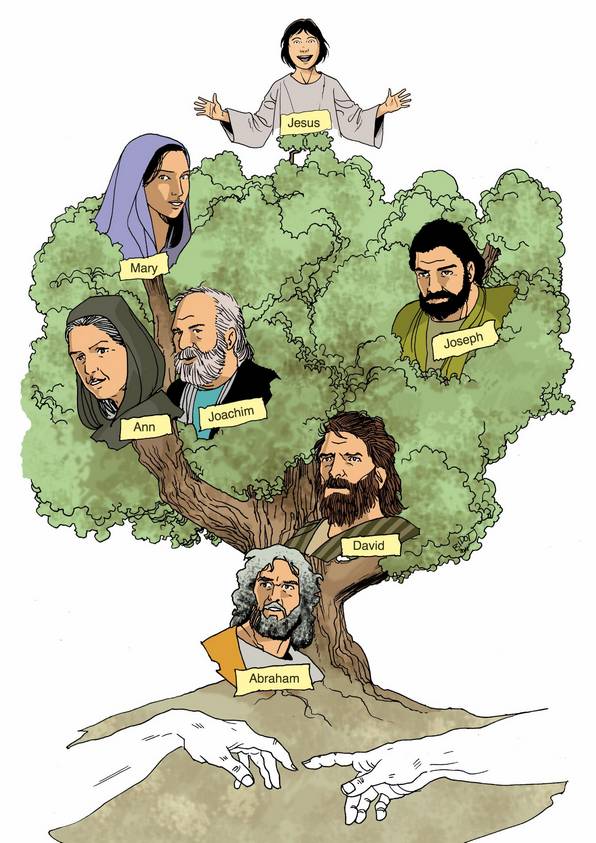
In the Garden of Eden, humanity turned away from its Creator. In this prophecy of Jeremiah, the text, where the Hebrew verb means “encompass”, “revolve around”, “look for”, expresses the resumption of a relation of love between Israel and its Spouse Yahweh. The vulgate stressed the messianic impact by the translation: “the woman must encompass the man with devotion” which evokes the virginal conception of Christ. * This Mariological interpretation from Jeremiah’s prophecy was proposed by Saint Jerome, Saint Bernard, Saint Thomas, Saint Bonaventure, Maldonat, Sanzio, Sa, Cornelius a Lapide, Van Est, Menochio, Tirinus; and recently, by Scholz, Meignan, Knabenbauer, Fillion, Reischl, Amdt, Herme, Closen S.J. (see verbum Domini, 1936, pp. 295-304).
The Spouse of the Song of Songs
The Song of Songs, i.e. the quintessential Hymn, through a sequence of poems, sings about the mutual love between a man and a woman who come together and lose each other, look for each other and find each other. The man is called “king” and “Solomon”, the woman, “Shulammite”. This Song has traditionally been interpreted as God’s love for Israel and that of its people for God. It follows that this first relationship of grace and love develops between Christ and his Church (Church, spouse of Christ) and between Christ and every soul. This relationship is ideally represented and made perfect in that of Mary with Christ and Mary with God. We will relate only several passages here which apply to the Virgin * But we refer the reader wishing to go into greater detail in the Song of Songs to the following work: André Feuillet, Comment lire le Cantique des Cantiques, Etude de théologie biblique et réflexions sur une méthode d’exégèse(How to read the Song of Songs, a Study of biblical theology and reflections on a method of exegesis), Editions Pierre TEQUI 1999. where we find this loving relationship to which we are all invited :
- For see, the winter is past * The description of spring, symbol of salvation, prelude to the call to return.,
- the rains are over and gone.
- The flowers appear on the earth,
- the time of pruning the vines has come,
- and the song of the dove is heard in our land. * As compared to Gn 8:8 and following. : Noah sent out a dove, to see if the waters had lessened on the earth. But the dove could find no place to alight and perch, and it returned to him in the ark… Putting out his hand, he caught the dove and drew it back to him inside the ark. He waited seven days more and again sent the dove out from the ark. In the evening the dove came back to him, and there in its bill was a plucked-off olive leaf!
- The fig tree puts forth its figs,
- and the vines, in bloom, give forth fragrance.
- Arise, my beloved, my beautiful one,
- and come! (SOS 2 :11-13)

- You are an enclosed garden,
- my sister, my bride,
- an enclosed garden, a fountain sealed. * SOS 4 :12 Enclosed garden, perfect and perpetual virginity, for the spouse will remain virgin. Isn’t she described as « my sister, my bride ».
- You are a garden fountain, a well of water
- flowing fresh from Lebanon. (SOS 4 :12, 15).
- …Let my lover come to his garden
- and eat its choice fruits. * SOS 4 :16 This enclosed garden, the spouse, invites her Creator to taste the fruits since they belong to him : « Let my lover come to his garden. »
- I have come to my garden,
- my sister, my bride;
- I gather my myrrh and my spices,
- I eat my honey and my sweetmeats,
- I drink my wine and my milk.
- Eat, friends; drink!
- Drink freely of love! * SOS 5 :1. God delights in his creature, Virgin, Mother of Jesus. He picks the fruit, the offering of Christ to the Father on the cross and in the Eucharist. And finally, he invites his people to receive communion for their salvation: Take and eat, this is my body…take and drink, this is my blood…”
Anne and Joachim, parents of the Virgin Mary
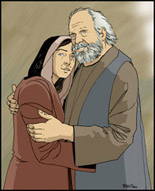 The four canonical evangelists tell us nothing about these two great saints, Saint Anne and Saint Joachim. We know of their existence through three apocryphal gospels * The apocryphal gospels contain certain passages which are possibly provided by the primitive tradition and complement the information in the Gospel.. The artistic representations we find in churches, paintings, sculptures¸ etc., often show them as being old. They had the joy of conceiving Mary at an advanced age, like Abraham and Sarah had Isaac at an advanced age or like Saint Elizabeth, later, conceived John the Baptist although she was already in her old age. Grandfather to Jesus, Joachim had married the wisdom of God contained in the heart of a righteous woman. They waited and hoped all their life to have a child, and so in their old age they received from God a girl, Mary.
The four canonical evangelists tell us nothing about these two great saints, Saint Anne and Saint Joachim. We know of their existence through three apocryphal gospels * The apocryphal gospels contain certain passages which are possibly provided by the primitive tradition and complement the information in the Gospel.. The artistic representations we find in churches, paintings, sculptures¸ etc., often show them as being old. They had the joy of conceiving Mary at an advanced age, like Abraham and Sarah had Isaac at an advanced age or like Saint Elizabeth, later, conceived John the Baptist although she was already in her old age. Grandfather to Jesus, Joachim had married the wisdom of God contained in the heart of a righteous woman. They waited and hoped all their life to have a child, and so in their old age they received from God a girl, Mary.
The Church honors Anne and Joachim to remind us of this very mysterious action of God for humanity. He wanted to save man by becoming one of us, by taking on our human condition, by entering into time and space. It is the means He chose above all others to better help us understand the intimacy He desires having with us and to which we are called. Saint Anne and Saint Joachim are the models for those faithful spouses who, living a just life before God, are careful to do his will to the best of their abilities and wait in faith and fervor the plenitude of the manifestation of the Lord. They thus contribute to the action of grace in the heart of their children, teaching them to believe, to respect and to love. * EPHATA Missal, Arthème Fayard bookstore, 1988, v. 3, p. 1696.
The Immaculate Conception
The little girl that Anne and Joachim brought into the world was granted an exceptional grace, a unique grace after the fault of our first parents : that of being the Immaculate Conception. The priest in Lourdes asked Bernadette Soubirous after one of the Apparitions that she had just experienced: “Do you know what Immaculate Conception means?” The poor girl answered, “No!” We are going to try to answer the priest’s question.
Adam and Eve had received original holiness and justice not only for themselves, but for all humankind. By giving into the tempter, Adam and Eve committed a personal sin, but that sin affects humankind itself. Thus they pass on to humanity their fallen state, by propagation. From then on, the nature of man is deprived of original holiness and justice. That is why the original sin is called “sin” in an analogous way: it is an “acquired” sin and not a “committed” one, a state but not an act. * CCC 404. Baptism, by giving life to Christ’s grace, erases original sin and turns man towards God, but the consequences for our nature, enfeebled and inclined to do bad, persist in man and call him to spiritual combat. * CCC 405
Without a special divine will, Mary, born of a man and a woman united in marriage according to the law of nature, would not have been any different from other creatures stemming from the contaminated root of Adam. She would have had her place in the grand line of “righteous” like many others in the Old Testament, but nothing more. Mary was, then, through exceptional grace, preserved from this inheritance from Adam and Eve. This grace bears a name, preserving Redemption. For there is a double Redemption: that which liberates from the fault into which one has fallen, thanks to the merit resulting from the accomplished Redemption, and the other – much more excellent – which preserves one from falling into fault in the first place, in anticipation of the forthcoming Redemption. The first is called liberating Redemption: it is common to all the descendants of Adam in an ordinary way. The second, preserving Redemption, is proper and exclusive to the Virgin Mary. Oddly enough, numerous and distinguished medieval theologians (among whom Saint Thomas of Aquinas and Saint Bonaventure) only understood Redemption, or salvation, to be the liberating Redemption of fault. * Gabriel Roschini OSM, The Virgin Mary in Maria Valtorta’s work, M. Kolbe and Pisani editions 1984, p 270. They could not imagine Mary the Immaculate Conception. However, another medieval theologian, the Blessed John Duns Scotus (O.F.M., 1308, beatified by John Paul II in 1993), gave the theological foundation to a devotion which had begun to spread in Ireland, Scotland and England in the XI century under the influence of the Eastern Church, without Rome intervening moreover to forbid it. This devotion was that of Mary’s Conception. Here are the essential texts of the Blessed Scotus’ analysis on the immaculate in the bareness and rigor of the argumentation * This central thought of John Duns Scotus is extracted from a conference given in Orsay, November 27, 1993 by Francis De Beer, OFM, The Lady according to the Heart of God, conference recorded in a booklet printed by C.A.T., St. Andrew Institute, pp. 15-16. :
The perfect Mediation of Christ
The most perfect mediator exercises the most perfect act of mediation possible with the person that he wants to benefit from his act. The Man Jesus Christ, being the most perfect Unique Mediator between God and man (as Saint Paul said), thus exercised the most perfect act of mediation with this person for whom he is the mediator. But this latter had no act of mediation more perfect than that with Mary. And the most perfect act was not to liberate from evil, but to preserve from evil. Thus Christ merited the preservation of Mary from original sin. Scotus explains indeed that it is a greater blessing to preserve someone from evil than to permit him to fall into sin and then to liberate him afterwards.
Moreover, this Preservation adds to the glory of Christ Mediator and Savior: Mary, Scotus says, actually had a greater need of the redeeming Christ than us. For she would have incurred original sin because of the shared propagation, if she had not been preserved by the grace of the Mediator. And if all the others need Christ so that their shared sin be forgiven, Mary had greater need of the Mediator to avoid the sin. In a way, Christ would not be the most perfect Redeemer if he had not merited that Mary be preserved from original sin.
In some ways, Mary is necessary, so that Christ perform at least once a perfect mediation. Otherwise, sin would be stronger than Christ, if Mary was not immaculate. * Let me emphasize the audacity of the profound thinking of Duns Scotus, attested to at that time, on the Virgin Mary. His subtle revolution is to not begin from a convenient hypothesis, such as “the greatest glory of God”, but to begin from a revealed fact: Christ the perfect mediator; and to find that only the immaculate conception of the Virgin, by a radical preservation from sin and not simply a purification of sin, fulfilled the conditions necessary for perfect mediation. For Duns Scotus, it was not about an argument of convenience, but a demonstration in faith. “Christ would not have been the perfect Mediator if he could not have given his mother the privilege of being preserved from original sin. I establish, in the name of the excellence of her Son as Redeemer and Reconciler and Mediator, that the Virgin did not contract original sin.” (see Léon Veuthey, John Duns Scotus, citing l'Oxoniense, 3, d3, ql, n4. – See also Ephrem Longpre, The Immaculate Virgin, p. 16). We must continually keep in mind Duns Scotus’ central thought inspired by Saint Paul : it is Christ who is the “First Born”, of whom Adam was only a rough draft, too quickly disfigured because of his immoderate love of Eve whom he did not wish to sadden by refusing the “apple” in the Garden of Eden. For Duns Scotus, everything is full of nuance! Fr. Francis De Beer, id. p. 40, note 139.
The Original Preservation of the Virgin
The first essential argument is founded on the Mediation of Christ. But Scotus must respond to an objection taken from the Virgin’s condition. Mary, as is said, was conceived in the same way as all other humans, by virtue of a generation subjected to the law of concupiscence. Her flesh then was infected; and the soul uniting with the flesh contracted the original blot. However, Mary was not exempt from the common pains of our nature: hunger, thirst, tiredness, suffering, death. These pains are the consequences of original sin which she contracted at birth. But this is the response from Scotus: These pains do not necessarily have a link with original sin. Jesus himself accepted them. Jesus could use his influence as mediator by preserving Mary from original sin, but leaving her the pains that she freely assumed (as Co-redeemer).
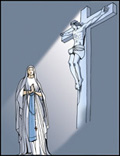
Duns Scotus’ Conclusion
« If this is not opposed to the authority of the Church or of the Holy Scriptures, it seems probable that it is necessary to attribute to Mary that which is the most excellent, that is to say the Immaculate Conception. »
In principle, in Duns Scotus’ thinking, there are always and more and more two joint assertions, in which he is truly son of Francis of Assisi. On the one hand he always asserts that the Immaculate Conception is his preference: Christ would not be the most perfect Mediator if he had not merited that Mary be preserved from original sin. Never will he betray it, even at risk to his own life. No less serious on the other hand, but how rich in meaning at that time, was his reserve: to only proclaim the Immaculate Conception to the extent that it was recognized by the authority of the Church. For Scotus, only the Church could assert the Immaculate Virgin as a truth of faith because the Church and Mary, for him as for Francis, are one and the same mystery, the Virgin Church.
This recognition from the Church will be made by the proclamation of the dogma * Christian dogma is the entirety of the doctrines that the Church teaches in the name of God. Its sources are the holy Scriptures and the Tradition. The dogmas are immutable. “To define a dogma” is not to create it but to declare officially that it must be believed by all the faithful. The “development of the dogma” is the progressive explanation of its content. of the Immaculate Conception in 1854 by Pope Pius IX:
« The most Blessed Virgin Mary was, from the first moment of her conception, by a singular grace and privilege of almighty God and by virtue of the merits of Jesus Christ, Savior of the human race, preserved immune from all stain of original sin. * CCC 491 »
The Birth of the Virgin Mary and her Presentation in the Temple
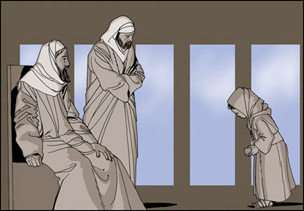 The Church traditionally celebrates the canonized saints on the anniversary of their death. This rule knows two exceptions: Saint John the Baptist, who is celebrated on June 25 (6 months before the birth date of Jesus): “And behold, Elizabeth, your relative, has also conceived a son in her old age, and this is the sixth month for her who was called barren” (Lk 1:36), and the Virgin Mary, who has more than twelve celebrations in the liturgical calendar: the Immaculate Conception (December 8); Mary, Mother of God (January 1); Our Lady of Lourdes (February 11); the Visitation (May 31); Holy Mary, comforter of the afflicted (Saturday after the 4th Sunday of Easter); the Immaculate Heart of Mary (Saturday of the 3rd week after Pentecost); Our Lady of Mount Carmel (July 16); the Assumption (August 15); Virgin Mary Queen (August 22) ; Virgin Mary Mediator (August 31) ; Nativity of the Saint Virgin (September 8, the date which was used to fix that of the Immaculate Conception, nine months before, December 8) ; Our Lady of the Rosary (October 7) ; Presentation of the Virgin Mary (November 21), dates to which must be added all those in which Mary is involved : Nativity of our Lord, the Holy Family, Epiphany, ..., Pentecost, celebration of the very Holy Sacrament.
The Church traditionally celebrates the canonized saints on the anniversary of their death. This rule knows two exceptions: Saint John the Baptist, who is celebrated on June 25 (6 months before the birth date of Jesus): “And behold, Elizabeth, your relative, has also conceived a son in her old age, and this is the sixth month for her who was called barren” (Lk 1:36), and the Virgin Mary, who has more than twelve celebrations in the liturgical calendar: the Immaculate Conception (December 8); Mary, Mother of God (January 1); Our Lady of Lourdes (February 11); the Visitation (May 31); Holy Mary, comforter of the afflicted (Saturday after the 4th Sunday of Easter); the Immaculate Heart of Mary (Saturday of the 3rd week after Pentecost); Our Lady of Mount Carmel (July 16); the Assumption (August 15); Virgin Mary Queen (August 22) ; Virgin Mary Mediator (August 31) ; Nativity of the Saint Virgin (September 8, the date which was used to fix that of the Immaculate Conception, nine months before, December 8) ; Our Lady of the Rosary (October 7) ; Presentation of the Virgin Mary (November 21), dates to which must be added all those in which Mary is involved : Nativity of our Lord, the Holy Family, Epiphany, ..., Pentecost, celebration of the very Holy Sacrament.
The celebration of the Nativity of the Virgin Mary is very ancient, since it was observed in Rome from the VIIth century. The song of the Introit, Salve, sancta parens, underlines the inseparable character of Mary and Jesus in the divine plan : Hail, O Holy Mother ; Mother who gave birth to the King who reigns in the sky and the earth forever and ever. From my heart sprang a beautiful poem : I dedicate my work to the King. The liturgy applies to Mary what our holy Books say of the eternal Wisdom, which is the Verb “by which everything was made”. Like Christ, the Virgin presides over every work of creation, since she was chosen from all eternity to give us the Savior. It is she with her son that God had especially in mind in creating the world.
The liturgical cycle celebrates the Presentation of the Virgin Mary in the temple in Jerusalem. This celebration is based on a pious tradition which originates from two apocryphal gospels in which it is reported that the Holy Virgin was presented in the Temple of Jerusalem at the age of three * The first document concerning the presentation of Mary in the temple at 3 years of age is the Protoevangelium of James written by a Christian around the middle of the IInd century (see G. Bonaccorsi. Vengili apocrifi, Florence, 1948, vol. I, pp. 71-75)., and that she lived there until her engagement, with other young girls and the holy women who took care of them.
The Annunciation
Six months before the Annunciation, the Angel Gabriel announced to Zachary in the temple of Jerusalem where he was in service, that he would have a son who would prepare for the Lord a people well disposed towards him. But for Mary, the place of the announcement was quite different. The angel Gabriel comes to visit her in her own home (Lk 1 :26-38): And in the sixth month [after the conception of John the Baptist announced by the angel Gabriel to Zachary], the angel Gabriel was sent from God into a city of Galilee, called Nazareth, to a virgin espoused to a man whose name was Joseph, of the house of David; and the virgin’s name was Mary. This difference of place suggests that from that instant God intends to make himself present among men, not only in the sanctuary, but in a totally new way¸ in the heart of their existence * P. Andrew (André) Feuillet, P.S. Sulp., The Messianic Savior and his Mother in the infancy narratives of Saint Matthew and Saint Luke, Divinitas, April 1990, p. 108 and following. Nota bene : the essence of the comments on the Annunciation is extracted from this study as well as, from the same author, Jesus and his Mother from the infancy narrative of Saint Luke and from Saint John – The role of the Virgin Mary in the history of salvation and the place of the woman in the Church, J. Gabalda and Co. Editors, 1974, pp. 20 et 21. This nota applies equally to all the paragraphs up to and including the one entitled “Mary Co-redeemer”.. And the angel Gabriel greets Mary by another name: “And the angel came in and said to her: Hail, full of grace,…” It should be noted in passing the use, in French, of the singular form of the word grace. It clarifies the meaning of the greeting. The angel Gabriel is not speaking about graces, as if it was simply about the numerous virtues of Mary or as if he wanted to tell her that she was gracious. She is full of grace, i.e. divine favor * Let us remember that the words « full of grace » from Lk 1 :28, are one of the key scriptural pillars of the dogma of the Immaculate Conception. It is clear this does not mean: you are full of divine grace and as a result the Lord is with you, but rather: you are full of divine grace because the Lord is with you. In Isaiah, ch. 7 and 8, it is by the anticipated action of Emmanuel (because “God is with us”) acting in history before he was born, that all the plans forged against the Davidic dynasty have been thwarted: “Form a plan it shall be thwarted; make a resolve, it shall not be carried out, for “With us is God!” (Is 8:10). It is likewise by the anticipated action of Emmanuel, of whom the Virgin Mary is destined to become the Mother (“because the Lord is with you”), that Mary was full of divine grace and preserved, right from her conception, from original sin.. Gabriel announces indeed to Mary the prodigious work (the mystery of the Incarnation) that through her God is ready to accomplish in the history of salvation. Then comes the end of the greeting where the verb is implied “…, the Lord (is) with you.” It is an often used form in the Bible (Gen. 21:22, 26:3, 26:24, 31:3, Ex. 3:12, Judg. 6:12, ...) where most of the time, especially like here where the verb is missing, it expresses the certain presence of an exceptional divine aid in particularly important circumstances for the history of salvation. We better understand Mary’s emotion of frightened modesty at the angel’s greeting: But she was greatly troubled at what was said and pondered what sort of greeting this might be.” And Gabriel declares to Mary that she is to become the Mother of the messianic Savior. His words are inspired by several messianic passages from the Old Testament: Behold, you will conceive in your womb and bear a son, and you shall name him Jesus * Jesus is the name of the Savior throughout his terrestrial life. Emmanuel is his most elevated name, that which he will carry eternally, equally that which is alluded to at the end of Matthew’s gospel when the ressurected Jesus, on the verge of leaving his apostles, promises them “to be with them” always (= God with us) even to the end of time Mt 28:20.. He will be great and will be called Son of the Most High, and the Lord God will give him the throne of David his father, and he will rule over the house of Jacob forever, and of his kingdom there will be no end.?”, a question which could seem strange since Mary was engaged to Joseph, from the house of David. In other words, she knew a man well but what she means by no knowledge is what the verb to know always expresses in these contexts: to have marital relations * Like Gen 4 :1 : Adam knew Eve his wife: who conceived and brought forth Cain… 4:17 Cain knew his wife, and she conceived, and brought forth Henoch… 4:25 Adam also knew his wife again: and she brought forth a son, and called his name Seth…. Although betrothed, Mary remained a virgin and seems, through these words, to have already previously made the resolution to remain as such * Mary was the Virgin : virgin of spirit, virgin of body, in the three phases of her life : before, during and after childbirth. Mary’s perpetual virginity is not a tradition which flourished because of a loving respect for the Blessed Mother of the Lord. It is the truth, and from the beginning it was known. Saint Matthew the Evangelist gives us, on this subject, unequivocal details. Concerning conception to birth, “he (Joseph) took unto him his wife. And he knew her not till she brought forth her firstborn son: and he called his name Jesus” (Mt 1 :24-25). And for the period following the birth, the Holy Scripture enables us to have certainties about Mary’s perpetual virginity (to which is added the Tradition of the Church). Matthew recounts “Arise, and take the child and his mother, and fly into Egypt » (Mt 2 :13) and “Arise, and take the child and his mother, and go into the land of Israel. For they are dead that sought the life of the child. Joseph arose, and took the child and his mother, and came into the land of Israel” (Mt 2 :20-21). In all three cases, Matthew specifies the child and his mother, not the child and your wife. If he does not use it, it is not because the word wife is prohibited at that time We find it, on the contrary, very often in the Gospels: “and the first having married a wife, died; and not having issue, left his wife to his brother...(Mt 22:25), “Whosoever shall put away his wife…” (Mk 10 :11) ; Luke calls Elizabeth « wife of Zechariah » four consecutive times (Lk 1:5, 13, 18, 24) and further on, “Joanna the wife of Chusa” (Lk 8:3). But in every case, as in the Old Testament, the word wife means that the marriage was consummated. There are many passages in the Old Testament which attest to this. Here are only given a few: “…a man leaves his father and mother and clings to his wife, and the two of them become one body.” (Gen 2 :24) ; Sarah is called the wife of Abraham (Gen 17 :15) ; and «Take with you your wife and your two daughters…” it is said to Lot (Gen 19:15). However, when it concerns Mary and Joseph, Matthew never uses the word wife, but his mother, his betrhothed: “When his mother Mary was betrothed to Joseph…” (Mt 1:18); “Jacob the father of Joseph, the husband of Mary. Of her was born Jesus… » (Mt 1 :16) ; « …take the child and his mother…” (Mt 2: 13; 20-21). The angel, saying thus at several years interval, « take the child and his mother » shows us that Mary is the true Mother of Jesus, but was not the wife of Joseph. She always remained the Virgin, betrothed to Joseph.
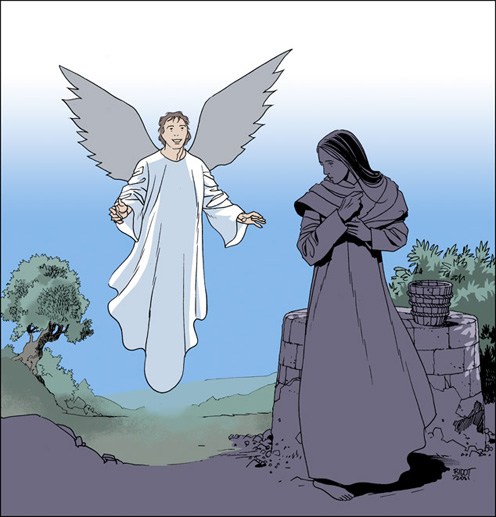
The perpetual virginity of the Virgin after childbirth is a testimony also to the chastity of Joseph. Joseph is just and pure: pure in his thoughts, pure in how he looks at people, pure in his acts. In Mary’s school, Joseph is a human being who is both wing and light. He sees the soul in her, not the flesh. Joseph lives, in the house the Lord has given him, according to the nazirite rules as told in the book of Numbers, chapter 6: the first rule expresses his consecration to God, letting himself be motivated by and acting through his force; the second indicates the rejection of an easy life; the third shows his special relationship with God. Joseph was just and followed the rules of the Nazirite. Through his marriage with Mary, he acted on the angel’s invitation in a most eminent way: “Joseph, son of David, do not be afraid to take Mary your wife into your home. For it is through the Holy Spirit that this child has been conceived in her” (Mt 1:20). By taking this course of action, he truly let God act through and in him. This acceptance did not give him an easy life (think about the exodus of several years spent in Egypt; Joseph had to work in a foreign country to feed his family). By accepting marriage to the Mother of the Savior, Joseph showed his special relationship to God. Indeed, a true Nazirite for his whole earthly life, Joseph is one of the greatest saints that the earth has ever known and it is he whom the Lord called on to be the virginal father of the Son of God and the spouse of the “Immaculate of God always Virgin”.
Finally, a passage from the Gospel of Matthew is not always easily understood and now seems like a good time to show and explain it: “While he was still speaking to the crowds, his mother and his brothers appeared outside, wishing to speak with him” (Mt 12:46). The term his brothers could make you think that Jesus had blood brothers and given that, that Mary did not remain Virgin after Jesus’ birth. Because of what is already said above, this would be to take a shortcut that does not apply. We need to know that in Aramaic, the language spoken in Jesus’ time, the words uncle, aunt do not exist. Uncle was referred to as my father; aunt as my mother; cousin as either my brother or my sister. Hebrew also uses brothers to denote kin or close cousins: Gen 13:8, 14:16 ; Lev 10:4 ; 1 Chr 23:22 and following. Thus this passage from Matthew does not bring into question the perpetual Virginity of Mary but simply denotes Jesus’ close kin. Another Gospel passage upholds this interpretation: Jesus on the cross says: "Woman, behold, your son." Then he said to the disciple, "Behold, your mother." And from that hour the disciple took her into his home. (John 19:26-27). If Jesus had had a blood brother, putting Mary into the well-beloved disciple’s hands would have been superfluous and even unacceptable. Mary would have had to be taken in by the blood brother (and not a person outside the family), because that is how it was done at the time of Jesus.

Let us keep ever present in our mind, Mary is Virgin. She is Unique. She is Perfect. She is Complete. Such is how she was envisioned. Such is how she was created. Such is how she lived. Such is how she was crowned Such is how she is eternally. She is Virgin. She is the abyss of intangibility, of purity, of grace, which loses itself in the Abyss from whence she sprang: God who is Intangibility, Purity.
Hence her question, “But how can this come about, since I have no knowledge of man?”, in other words, “since I am keeping my virginity.” And the angel’s response to her legitimate question specifies not only the “how can this come about”, but equally informs her that the mystery of the Incarnation will be realized: “The Holy Spirit will come upon you and the power of the Most High will cover you with its shadow. And so the child will be holy and will be called Son of God.” We can only compare this to the announcement from the Exodus passage: “Then the cloud covered the tent of meeting, and the glory of the LORD filled the tabernacle. Moses could not enter the tent of meeting, because the cloud settled down upon it and the glory of the LORD filled the tabernacle” (Ex 40:34-35). The cloud, symbol of divine transcendence, which covers the tabernacle, corresponds to the Holy Spirit which comes over Mary, or even the virtue of the Almighty which covers her. The glory of the LORD which fills the tabernacle corresponds to the supernatural conception in Mary of a being who deserved to be called Holy and Son of God, for the angel announces to Mary a strictly divine maternity.
We see that the Virgin Mary was already, at the Annunciation, the first recipient of the revelation of the Trinitarian Mystery * This narrative from Luke of the Annunciation shows the marvel of the Incarnation achieved through the intervention of the three Persons of the Trinity: 1) thanks to the initiative of the Father: “the angel Gabriel was sent from God” (v. 26); 2) thanks to the own Son of God who must become Mary’s son, which does not prevent him from being and so to always be called “the Son of the Most High” (v. 32); 3) thanks to the action of the Holy Spirit who must “come upon Mary” (v. 35), as he must come upon the apostles at Pentecost, the Spirit being always, in the Scripture, the supreme source of life., thus before the revelation of the ineffable mystery given to John the Baptist at Jesus’ Baptism, and the great manifestation of this same mystery given to the entire newborn Church at Pentecost.
Here is another observation from Jesus’ conception: thanks to the all powerful intervention of the Holy Spirit, Mary is not the Mother of a man become God; she is the Mother of a human being whose person was always divine because of the laws which were in effect at his conception: she is the Mother of God. We find here the greatest originality of the Christian religion. It is not in the first place a set of doctrinal statements or moral rules, but a divine Person.
And behold, Elizabeth, your relative, has also conceived a son in her old age, and this is the sixth month for her who was called barren; for nothing will be impossible for God. The
announcement made to Mary informs her that her relative is 6 months pregnant, she who had never had a child and who had passed the age for having one. The end of the announcement shows that, there too, though differently, God miraculously intervened for Mary as Yahweh had intervened for Sarah and Abraham for is anything too marvelous for the Lord to do? (Gen 18 :14)
The scene of the Annunciation ends with Mary’s fiat : "Behold, I am the handmaid of the Lord. May it be done to me according to your word." Later, Jesus gives himself entirely; he will declare himself to have come in order to serve (Mk 10:45 ; Mt 20:28 ; Lk 22:27; Phil 2:6-11). By taking the title of “handmade of the Lord”, Mary also enters into the divine plan of salvation with the total giving of herself. Her fiat announces the “your will be done” of the Lord’s Prayer (Mt 6:10), or even the “not my will but yours be done” from Gethsemane (Lk 22:42). Finally, her perfect submission is the antithesis of Eve’s disobedience. Eve trusted the serpent, Mary trusts Gabriel; the evil that Eve did in believing the angel of darkness, Mary erases through her trust in the angel of the Lord. In the Annunciation, indeed, there is no need to renounce any reference to Eve, and here is why. In the achievement of the mystery of the Incarnation, the scene of the Annunciation brings in the divine Spirit who swept over the waters as a life-giving force (Gen 1:2). It also brings in the almighty Word of God for whom nothing is impossible. In God, word and action coincide and this sovereign effectiveness of the divine Word first sprang forth in the creation: “for, the moment he spoke, it was so” (Ps 33:9). The Virgin Mary remembers this when she abandons herself to God for whom to say and to do are one and the same: “May it be done to me according to your word.” That means that she abandons herself to the intervention of the Spirit announced by Gabriel. It seems that in this way we are discreetly redirected to the first creation, a work both of the Word and the divine Spirit (Gen 1), which brings about the Incarnation as the point of departure for a new humanity and Mary as a new mother of the living.
The Visitation
The ark of the LORD remained in the house of Obed-edom the Gittite for three months” (2 Sam 6 :11) and “Mary abode with her about three months” (Lk 1:56). So Mary is identified as the Ark of the Covenant where the Lord comes to live.
The Precursor’s leaping for joy in Elizabeth’s womb is a messianic joy. Indeed, Luke writes in all his childhood narratives that the joy of the messianic era explodes with Jesus (Lk 1:14, 28, 47 ; 2:10). The Baptist’s joy in his mother’s womb is a part of this theme. What is remarkable here is that the Spirit and joy are given to Elizabeth by Jesus living in the womb of Mary: “For at the moment the sound of your greeting reached my ears, the infant in my womb leaped for joy.” And so it is through Mary that the gift of the Messiah is given to mankind and the graces thereof. From this is it not normal that she be proclaimed by Elizabeth “blessed among women”, meaning blessed more than all the other women, as was already said of Judith (Jdt 13:18) ? The honor that falls to Elizabeth is without a doubt, above all, the visit of her Lord present in Mary, but it is also the visit of Mary: “And how is it that the mother of my Lord should come to me?”

Elizabeth ends the Visitation episode by praise for Mary’s faith: “Blessed are you who believed that what was spoken to you by the Lord would be fulfilled.” (Lk 1:39-45). In fact, the Virgin Mary is the model for believers. Saint John, notably at the end of his gospel, presents faith as the fundamental attitude of a disciple of Jesus: You believe because you can see me. Blessed are those who have not seen and yet believe” (John 20:28). We are not necessarily aware of it, but it is definitely Mary’s faith which is indirectly exalted by her son during his public life, even when from the middle of the crowd a woman of Israel addresses him, “Blessed the womb that bore you and the breasts that fed you!” But Jesus responds, “More blessed still are those who hear the word of God and keep it!” (Lk 11 :27-28). Who, better than Mary, listened to the word of God and lived by it ? Without her faith, indeed, her physical motherhood would have been as nothing. However, and Luke’s gospel makes this point very strongly, Mary is the epitome of the souls which listen and keep the word of God.
Mary’s response to her cousin Elizabeth is this magnificent song of thanksgiving…
The Magnificat
- My soul proclaims the greatness of the Lord;
- my spirit rejoices in God my Savior.
- For he has looked upon his handmaid's lowliness;
- behold, from now on will all ages call me blessed.
- The Mighty One has done great things for me,
- and holy is his name.
- His mercy is from age to age
- to those who fear him.
- He has shown might with his arm,
- dispersed the arrogant of mind and heart.
- He has thrown down the rulers from their thrones
- but lifted up the lowly.
- The hungry he has filled with good things;
- the rich he has sent away empty.
- He has helped Israel his servant,
- remembering his mercy,
- according to his promise to our fathers,
- to Abraham and to his descendants forever.
What we receive from this canticle of the Magnificat proclaimed by Mary is perhaps first of all her peaceful humility. Mary does not shout from the rooftops what has happened to her but proclaims that her soul exalts the Lord, and her spirit leaps for joy because of God her Savior. The link between the Magnificat and the canticle of Samuel’s mother has been underscored by many. But while that of Anne has, from the beginning, focused on a triumphant personal revenge over her enemies, “My heart exults in Yahweh, in my God is my strength lifted up, my mouth derides my foes” (1 Sam 2 :1), Mary’s is full of the peaceful humility which characterizes her, “For he has looked upon his handmaid's lowliness; behold, from now on will all ages call me blessed.” A certain identification of Mary with the Daughter of Zion equally emerges from the Magnificat. The words “My spirit rejoices in God my Savior” echoes a song of an Israel besieged by Chaldean oppressors: “But I shall rejoice in Yahweh, I shall exult in God my Savior.” (Hab 3:18). The action of Mary’s personal grace is at one and the same time for all the poor (the portion chosen from the people of Israel), all the little people and, of course, all those who consider themselves sinners: “He has thrown down the rulers from their thrones, but lifted up the lowly…” The Magnificat enables us to see in Mary, Mother of Christ, the perfect realization of evangelical “poverty” understood with the profound meaning it had acquired little by little in the Old Testament and such as is definitively expressed in the Sermon on the Mount: “Blessed are the poor in spirit: for theirs is the kingdom of heaven.” (Mt 5 :3)
Finally from the Magnificat, Abraham’s evocation, in whom, in the beginning, the elected people came to be identified, suggests that now it is in Mary that the people of God are found. This evocation of Abraham joins those which had already been made in the narrative of the Annunciation: “you have found favor with God” (Gen 18:3 and Lk 1:.0) and “nothing is impossible to God” (Gn 18:14 and Lk 1:37). We understand that to Abraham’s act of faith, starting point for the people of God in the old covenant, is now juxtaposed the act of faith of Mary, starting point for the people of the new covenant. It is by the new covenant that the promises made in the old covenant to Israel, Abraham and his posterity will from now on be fulfilled.
Jesus’ birth and tribute to the shepherds
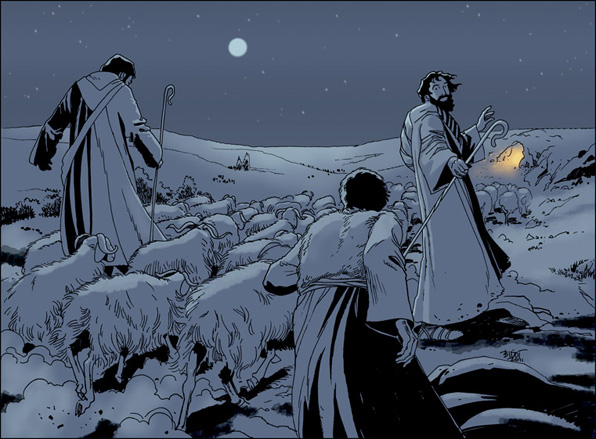
The structure of Saint Luke’s narrative in its first two chapters brings into contrast the two births of the Baptist and Jesus: the second outweighs the first in as much as Christ the Lord surpasses his precursor. Yet, by an extraordinary paradox, while the first birth took place in a climate of plenty, the second birth, that of Jesus, took place in the most absolute deprivation, that of the child, but above all of his Mother, the Virgin Mary. The extreme destitution which surrounds Jesus’ birth, unlike that of the precursor, portends his poverty and suffering as Messiah. However here it is not Jesus who suffers directly, but through his Mother who is compelled to make a long and arduous journey ending in the refuge of a stable. This impoverishment is all the more striking in that it is recounted simply, without eloquent sentences, as if it is the most natural thing that he who must die on a cross in unspeakable suffering to which his Mother will be witness should appear thus on the world scene: “and she gave birth to her firstborn son * "In Biblical Greek, the term does not necessarily imply younger brothers, but emphasizes the child's dignity and rights.".. She wrapped him in swaddling clothes and laid him in a manger, because there was no room for them in the inn.”
 The Luke infancy narratives are certainly Christological, but in them the Virgin Mary is inseparable from Christ. The amazing sign given to the shepherds by the angels is only about Christ: “And this shall be a sign unto you. You shall find the infant wrapped in swaddling clothes, and laid in a manger.” The shepherds set off to seek the child and they find him with Mary, and so to speak, by Mary: “And they came with haste; and they found Mary and Joseph * Joseph’s name comes after the Virgin because he is not Jesus’ biological father., and the infant lying in the manger.” Thus we could say that those today who seek Christ can find him with Mary, by Mary. In so doing, they do not take a detour to follow the Way, the Truth and the Life, but rather a shortcut leading them to he who is our God and our all.
The Luke infancy narratives are certainly Christological, but in them the Virgin Mary is inseparable from Christ. The amazing sign given to the shepherds by the angels is only about Christ: “And this shall be a sign unto you. You shall find the infant wrapped in swaddling clothes, and laid in a manger.” The shepherds set off to seek the child and they find him with Mary, and so to speak, by Mary: “And they came with haste; and they found Mary and Joseph * Joseph’s name comes after the Virgin because he is not Jesus’ biological father., and the infant lying in the manger.” Thus we could say that those today who seek Christ can find him with Mary, by Mary. In so doing, they do not take a detour to follow the Way, the Truth and the Life, but rather a shortcut leading them to he who is our God and our all.
Lastly, Mary’s attitude, such as it is described in this nativity scene as well as in the scene of finding Jesus in the temple, prefigures marvelously the clearly contemplative orientation of Christian life: “As for Mary, she treasured all these things and pondered them in her heart.” » (Lk 2 :19, 51). It is perhaps in the scene of the presentation of Jesus in the Temple that we see best the culmination of Mary’s contemplation.
Jesus’ presentation in the temple
Obedient to the liturgical requirements of their time, Joseph and Mary present the child Jesus for the purification rite. Yet, as they arrive at the temple, a devout and righteous man takes the child in his arms and blesses God. He then says to Mary, his Mother: “See, your son who is here will provoke the fall and rise of many in Israel. He will be a sign that will be contradicted. And you, your heart will be pierced by a sword so that the thoughts of many hearts may be revealed.” We often speak here of the two-edged sword of pain. But the sword means more than great suffering; it symbolizes a violent death and brings to mind the atrocious drama of the Passion. Notwithstanding Simeon foresees this sword, not directly reaching the Messiah, but piercing his Mother’s soul: and you yourself a sword will pierce.” The union of Mary to Jesus will be such that she will be pierced by a deadly sword when the drama of the Passion unfolds. And so then, the contemplation of Jesus pierced for our sins will lead Mary to a sort of spiritual transfixion * Transfixion is a procedure of’amputation consisting of boring into the part to be amputated then cutting the flesh from the inside out.. This will be the perfect realization, matchless in the Virgin Mary, of the contemplative Christian life such as John the Evangelist conceived of it: to never cease to look, with faith and love, to he whom the sins of man pierced.
Finding Jesus in the temple
Jews thirteen years and older had to go up to the Temple in Jerusalem three times a year * For the feasts of Easter, Pentecost and the Tabernacles (Ex 23 :14-17 ; 34 :23 ; Dt 16 :16).. The children also could be taken there to accustom them to the rituals. Luke suggests that at the age of twelve, Jesus goes up to the holy city for the first time. On the return trip, an incident occurs. Jesus stays in Jerusalem without Joseph and Mary realizing it. Filled with distress, they start looking for him and only at the end of three days of agony do they find him in the Temple, “sitting in the midst of the teachers, listening to them and asking them questions,.” * Lk 2 :46-47. Let us note in passing that Mary and Joseph find Jesus like we all end up finding God (or Christ) when we seek him assiduously. When his parents saw him, they were astonished, and his mother said to him, “Son, why have you done this to us?
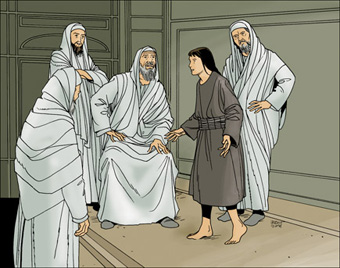 Your father and I have been looking for you with great anxiety.m” (Lk 2:33). These two comments could give the impression that Joseph and Mary were totally ignorant of Jesus’ divine paternity. That is not at all the case. The Annunciation made by the angel to Mary and the message given by the angel to Joseph (Lk 1:26-38 and Mt 1:20-21) exclude this interpretation. Jesus’ question confirms this certainty: “Did you not know?” They could have answered yes. But having become used to living with Jesus on a human level, they suddenly are invited, without any transition, to rise to the sphere of divine life and to the Father’s plan of salvation which determines his incarnate Son’s existence. Jesus uses the word Father in a new way. Mary had just said, “your father and I have been looking for you”, and Jesus replies, “I must be in my Father’s house.” All the witnesses there (the doctors of law notably) are faced with the super-intelligibility of the event, i.e. that the blinding splendor of God’s glory veils from man the obvious facts. Mary, full of grace, the Lord with her, spouse of the Holy Spirit, is the only one to fully understand * Mary had wisdom from the moment of her immaculate conception, but “on the mountain” she received God’s secrets and we can say that the Verb lived in her since she existed. And so the saints and doctors of the Church, among whom Saint Albert the Grand, concluded that Mary - before receiving in her very pure and inviolate womb the Word of the Father to clothe him in the flesh of the Redeemer – had had in her heart and possessed in her immaculate heart the divine Word, from the moment she had the immaculate soul infused in her flesh, in Ann’s womb. And it is the Word that was her veritable Master before being her Son.. But, without doubt so as not to mortify Joseph to whom the plenitude of grace is not granted, Mary keeps the sublime meaning of her Son’s words: “His mother stored up all these things in her heart.” (Lk 2 :51)
Your father and I have been looking for you with great anxiety.m” (Lk 2:33). These two comments could give the impression that Joseph and Mary were totally ignorant of Jesus’ divine paternity. That is not at all the case. The Annunciation made by the angel to Mary and the message given by the angel to Joseph (Lk 1:26-38 and Mt 1:20-21) exclude this interpretation. Jesus’ question confirms this certainty: “Did you not know?” They could have answered yes. But having become used to living with Jesus on a human level, they suddenly are invited, without any transition, to rise to the sphere of divine life and to the Father’s plan of salvation which determines his incarnate Son’s existence. Jesus uses the word Father in a new way. Mary had just said, “your father and I have been looking for you”, and Jesus replies, “I must be in my Father’s house.” All the witnesses there (the doctors of law notably) are faced with the super-intelligibility of the event, i.e. that the blinding splendor of God’s glory veils from man the obvious facts. Mary, full of grace, the Lord with her, spouse of the Holy Spirit, is the only one to fully understand * Mary had wisdom from the moment of her immaculate conception, but “on the mountain” she received God’s secrets and we can say that the Verb lived in her since she existed. And so the saints and doctors of the Church, among whom Saint Albert the Grand, concluded that Mary - before receiving in her very pure and inviolate womb the Word of the Father to clothe him in the flesh of the Redeemer – had had in her heart and possessed in her immaculate heart the divine Word, from the moment she had the immaculate soul infused in her flesh, in Ann’s womb. And it is the Word that was her veritable Master before being her Son.. But, without doubt so as not to mortify Joseph to whom the plenitude of grace is not granted, Mary keeps the sublime meaning of her Son’s words: “His mother stored up all these things in her heart.” (Lk 2 :51)
This episode of Jesus lost and found in the temple was for Mary the cause of very great suffering which added to that already experienced through Simeon’s prophecy. In this way the very difficult separations in the future were prepared for: firstly that which represented for her the entry of the Messianic Savior into his public ministry. Then and especially the incomparably more painful ordeal that the atrocious drama of the Passion must have been for her.
They have no more wine
The power of Mary’s meditation is demonstrated in the narrative of the wedding in Cana. It is important to situate the scene in time. Jesus leaves his Mother, to whom he was subject until then, to begin his public ministry. He meets John the Baptist in Bethany beyond the Jordan. John the Baptist recognizes him and points him out to some of his disciples as being the Lamb of God. These follow him and only several days later, Jesus and his first disciples rejoin Mary in Cana in Galilee; for they are all invited to a wedding feast. Yet there is not enough wine. For a wedding feast, this small detail means catastrophe. Jesus’ mother tells him, “They have no more wine.” What important intention pushes Mary to make such a request to her son? Is it only to come to the aid of the wedding hosts? What motivates Mary above all to make her request is, knowing through her faith that Jesus is the Messiah and the Son of God, she understands that the time has finally come for him to make manifest his presence in the world, as Messiah and as Son of God: the theophany at the baptism of Jesus in the Jordon, ministry of the Precursor, did it not make her see this Messianic demonstration as imminent ?
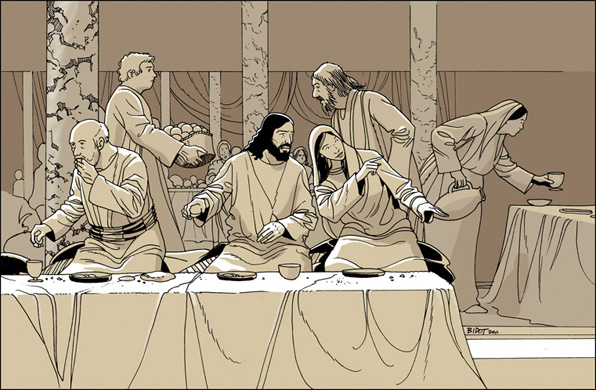
How could Mary’s maternal intuition not have known? A mother is bound in an extraordinary way to her child, and she is always extremely attentive to everything that concerns his life and destiny. It is certainly not for herself that Mary sought this Messianic manifestation. Her faith had no need of it. But it is for those first disciples that Jesus brought with him to Cana and whose convictions were still very shaky. When Jesus had performed the miracle, the evangelist notes that “his disciples believed in him.” He carefully avoids saying that Mary also believed in him. However, what the evangelist strongly suggests to us is that Mary’s faith, which according to Saint Luke is there at the beginning of the fulfillment of the mystery of the incarnation, is here at the beginning of Jesus’ public ministry and Christian faith: Mary believed before any of the disciples and her faith even led to the sign that brought the disciples to faith. Jesus’ reply to Mary could seem hard, although we cannot imagine that he said it with harshness, “Woman, what is that (from now on) to me and to you? My hour has not yet come.” As if to show that “before, you commanded and I obeyed. I was submissive to you. Now, I am subject to my mission. I belong to my Father.” But his manner of responding must have expressed agreement with his Mother’s prayer since she finally addresses the servants in this way, “Do whatever he tells you.” The use of the word “Woman” and not (no longer) the term “mom” means that the ties with his Mother have been transformed from this moment on into that of a more elevated nature. Jesus calls his Mother “Woman” because she is the new Eve associated with the new Adam for the salvation of the world (Lk 2:51). The end of Jesus’ reply “My hour has not yet come.” reminds us of the Passion and the Resurrection of the great messianic manifestation to come. But could Mary understand in Cana that Jesus’ Hour had come? Nevertheless Mary has this attitude of faith which reminds us of the “May it be done to me according to your word.” She tells the servants, “Do whatever he tells you.” It is after Mary’s expression of total confidence that Jesus accomplishes the miracle that she wants him to. By expressing her faith in Jesus, Mary hastens, or rather brings about already, the coming of Jesus’ Hour. Mary appears thus as the mediator between God and men. She is the one who gives God to man and man to God by educating them through her love. She is the Holy Door which opens with benevolence when a child of God knocks there with love. And the more humble and simple the spirit that turns to her, the faster she hurries to open and welcome it. She receives them so as to teach them wisdom and love, holding her children in her Mother’s arms.
At the hour of Jesus, « Woman, behold thy son »
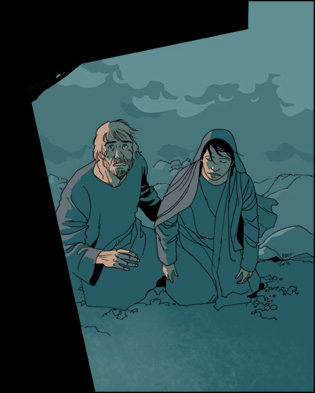 The role of Jesus’ disciples’ spiritual Mother, already foreshadowed in Cana, will be played out fully by Mary in Golgotha. The hour of Jesus is come. It is also the hour of the metaphorical birth of the new world that the prophets attribute to the chosen nation, personified by them as being a woman, Yahweh’s spouse, named Daughter of Zion or Zion. Jesus has just been nailed to the cross. While the ordeal continues, the soldiers share out his clothes. Now there stood by the cross of Jesus, his mother, and his mother’s sister, Mary of Cleophas, and Mary Magdalen. When Jesus therefore had seen his mother and the disciple standing whom he loved, he saith to his mother: Woman, behold thy son. (John 19 :25-26). In Christ’s eyes, Mary is the Daughter of Zion to whom he attributes the metaphorical supernatural motherhood that the prophets had spoken of. To Mary, who sees her son die on the cross, to Mary, the new Eve, God gives a new son ‘in place of Abel killed by Cain (Gen 4:25-26). But the new son given by Jesus to his Mother encompasses not only John himself, but all Christ’s disciples, members of his mystical body. Indeed, the five episodes relative to the Calvary reported by Saint John (John 19 :17-37) all include, besides the event’s literal meaning, a theological and messianic meaning much more profound that the author lets us find for ourselves. The attaching of the title on the cross (John 19 :17-22) suggests Christ’s royalty. The sharing out of the garments (John 19:23-24) suggests Christ’s priesthood and the unity of the Church. Christ’s thirst (John 19 :28-30) suggests the gift of the Spirit. The lance’s piercing (John 19 :31-37) (the transfixion) tells us that Christ is the Christians’ paschal lamb. And so the farewell scene between Christ and his Mother is not limited to a simple human and family impact. In these words of Christ, Jesus gives us to understand that Mary, his Mother, becomes, in Calvary, the spiritual Mother of Christians. After having physically given birth to Christ in Bethlehem, Mary becomes in Golgotha the Mother of the Church, the mystical body of Christ.
The role of Jesus’ disciples’ spiritual Mother, already foreshadowed in Cana, will be played out fully by Mary in Golgotha. The hour of Jesus is come. It is also the hour of the metaphorical birth of the new world that the prophets attribute to the chosen nation, personified by them as being a woman, Yahweh’s spouse, named Daughter of Zion or Zion. Jesus has just been nailed to the cross. While the ordeal continues, the soldiers share out his clothes. Now there stood by the cross of Jesus, his mother, and his mother’s sister, Mary of Cleophas, and Mary Magdalen. When Jesus therefore had seen his mother and the disciple standing whom he loved, he saith to his mother: Woman, behold thy son. (John 19 :25-26). In Christ’s eyes, Mary is the Daughter of Zion to whom he attributes the metaphorical supernatural motherhood that the prophets had spoken of. To Mary, who sees her son die on the cross, to Mary, the new Eve, God gives a new son ‘in place of Abel killed by Cain (Gen 4:25-26). But the new son given by Jesus to his Mother encompasses not only John himself, but all Christ’s disciples, members of his mystical body. Indeed, the five episodes relative to the Calvary reported by Saint John (John 19 :17-37) all include, besides the event’s literal meaning, a theological and messianic meaning much more profound that the author lets us find for ourselves. The attaching of the title on the cross (John 19 :17-22) suggests Christ’s royalty. The sharing out of the garments (John 19:23-24) suggests Christ’s priesthood and the unity of the Church. Christ’s thirst (John 19 :28-30) suggests the gift of the Spirit. The lance’s piercing (John 19 :31-37) (the transfixion) tells us that Christ is the Christians’ paschal lamb. And so the farewell scene between Christ and his Mother is not limited to a simple human and family impact. In these words of Christ, Jesus gives us to understand that Mary, his Mother, becomes, in Calvary, the spiritual Mother of Christians. After having physically given birth to Christ in Bethlehem, Mary becomes in Golgotha the Mother of the Church, the mystical body of Christ.
At the Hour of Jesus, « Behold your mother »
In the Old Testament, the chosen nation has as its mission to give to humanity its Savior, without this latter ever being called the Messiah’s Mother. Furthermore, the prophecies often present the Daughter of Zion as the Mother of God’s new people (but not of the personal Messiah). Yet it is only through Mary that the chosen nation and the Daughter of Zion fulfilled the function that Yahweh had assigned them in the world’s religious history. The Luke childhood narratives imply it, since Mary in her Magnificat sees in what happens to her the accomplishment of the promises made to Abraham and that she is herself presented, in veiled terms, as a sort of incarnation of the Daughter of Zion.
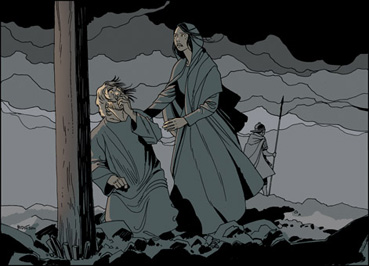 Jesus, from the height of his cross, teaches us who to go to so as not to remain a-lone: to Mary who is our Mother. “Behold your mo-ther” (John 19:27). From everything that has been said above, it appears that the words directed to Saint John are also directed to us, to each one of us personally. Through his unique filial love for Mary, John is the “prototype” of her children. And if we become like little children, we will enter the Kingdom of Heaven * Mk 10 :13 : « Let the children come to me; do not prevent them, for the kingdom of God belongs to such as these. Amen, I say to you, whoever does not accept the kingdom of God like a child will not enter it. ». Let us not believe though, that we can enter the kingdom of heaven as brave little children who know how to walk alone. Let us entrust our childhood to our Mother. She will carry us on her breast, on her heart. She will feed us the milk of her love. Mary is our Mother, not in a symbolic sense but truly, because our Mother is she who gives life. Mary, the ark of the covenant of the Christian people, gave us life and consequently the Holy Spirit, i.e. he who maintains life in us. Moreover, Mary makes of us carriers of Christ and even other Christs, according to the words of Saint Paul, “It is no longer I who live, but Christ who lives in me.”
Jesus, from the height of his cross, teaches us who to go to so as not to remain a-lone: to Mary who is our Mother. “Behold your mo-ther” (John 19:27). From everything that has been said above, it appears that the words directed to Saint John are also directed to us, to each one of us personally. Through his unique filial love for Mary, John is the “prototype” of her children. And if we become like little children, we will enter the Kingdom of Heaven * Mk 10 :13 : « Let the children come to me; do not prevent them, for the kingdom of God belongs to such as these. Amen, I say to you, whoever does not accept the kingdom of God like a child will not enter it. ». Let us not believe though, that we can enter the kingdom of heaven as brave little children who know how to walk alone. Let us entrust our childhood to our Mother. She will carry us on her breast, on her heart. She will feed us the milk of her love. Mary is our Mother, not in a symbolic sense but truly, because our Mother is she who gives life. Mary, the ark of the covenant of the Christian people, gave us life and consequently the Holy Spirit, i.e. he who maintains life in us. Moreover, Mary makes of us carriers of Christ and even other Christs, according to the words of Saint Paul, “It is no longer I who live, but Christ who lives in me.”
Finally, through her motherhood and meditation, Mary appears as the archetype of the Church. Indeed, though on a lower plane * In the old days, the ark of the covenant guarded the Saint of Saints in the mysterious presence of Yahweh. This presence was the chosen nation’s great treasure. It was the source of their pride and strength. They leaned on this strength in times of trouble. Yet twice in the Luke narratives (Lk 1:35 and 43), it is suggested that Mary is the new ark of the covenant, that of the era of grace, and so that of the Church. It is moreover only when united indissolubly with Jesus that Mary merits this title. Mary, the ark of the covenant for Christians, is the hidden source of their life and their great recourse, especially in times of crisis. Thus we see how Mary, in the Church because she is full of grace, is above the Church, a little like a mother is above her child. For Mary, through her total fiat which created this extraordinary connection with God the Trinity, exceedingly surpasses the Church. That is precisely why the Church invokes Mary’s intervention unceasingly., the Church is also mother and mediator. Mary is the perfect model of the Church. It is in becoming more and more like Mary that the Church attains the Founder’s intention: “…as you, Father, are in me and I in you, that they also may be in us, that the world may believe that you sent me... Father, they are your gift to me. I wish that where I am they also may be with me, that they may see my glory that you gave me, because you loved me before the foundation of the world.” (John 17 :21-24).
Mary, Co-redeemer
For us, Mary shared in Christ’s suffering, in the suffering of humanity’s Redeemer. This agony lasted thirty-three years * United in the Spirit of Wisdom, Mary knew from his conception what the future held for the Savior. And all of that for us, mankind: for us, the pain of making Joseph suffer who does not yet know of the virginal conception when Mary, her pregnancy beginning to show, comes back from Elizabeth’s; for us, childbirth in a miserable stable; for us Simeon’s prophecy, rubbing salt in the wound, reawakening and deepening the sword’s wound; for us, the flight to a foreign land; for us, the worries of an entire life… and culminated at the foot of the cross. If the evangelist Saint John does not breathe a word of Mary’s suffering in the account of the Passion, it is clearly implied in the announcement of a prompt return which Jesus speaks of to his apostles during the last supper: “When a woman is in labor, she is in anguish because her hour has arrived; but when she has given birth to a child, she no longer remembers the pain because of her joy that a child has been born into the world.” (John 16:21). In Jesus’ mouth, there is an unmistakable association of Mary’s hour and his own Hour which he refers to at the wedding in Cana.
The Co-redemption is this collaboration to redeem the earth, i.e., humankind, to deliver it from the slavery of sin and death. Mary, through her suffering and sacrifice, participated in Christ’s deliverance of humanity. Saint John’s Revelation strongly expresses this: “Now a great sign appeared in heaven: a woman, clothed with the sun, standing on the moon, and on her head a crown of twelve stars. She was pregnant, and in labor, crying aloud in the pangs of childbirth. * Rev 12 :1-2. Nota : it would be wrong to consider that the two verses make no allusion to the Virgin Mary, in the same way that it would be wrong to consider that the two verses make allusion only to the Virgin Mary. Saint John’s text from Revelation is one of the most difficult in all the New Testament. Indeed, an apocalyptic vision is quite different from an historical account. We cannot adequately explain Rev 12 if we do not accept from the outset that the author has in a way collapsed and melted together into one vision realities that are obviously intimately united but perfectly distinct. In this way he merged Christ’s physical birth in Bethlehem to his metaphorical birth at Calvary, which allows him to speak of the atrocious pain of childbirth. But the Woman crowned with stars who gives birth to Christ is equally a personification of God’s people, and more particulary of the ideal Zion of the prophets like we see in the very clear reference of Rev 12:5 to Isaiah 66:7 where Zion gives birth to the messianic people.” What is perhaps the most surprising in this passage from Revelation is that John, instead of directly describing Jesus’ Passion, writes only about the Compassion of his Mother tortured in childbirth. Everything happens as if Jesus’ Passion and Mary’s Compassion were one and the same. We find the same phenomenon in Simeon’s prophecy. Certainly in both cases, Jesus remains man’s unique Savior. But in both cases, his Mother’s suffering is considered inseparable form his own redeeming suffering. Redeemer and Co-redeemer: new Adam and new Eve, for the salvation of humanity.
Mary, queen of the apostles and priesthood
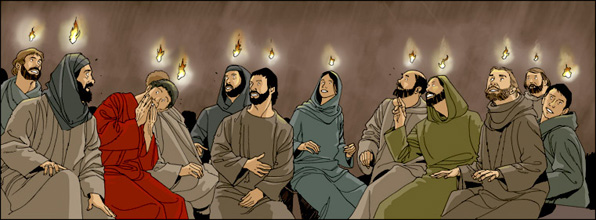 And they were all filled with the Holy Spirit and began to speak in different tongues, as the Spirit enabled them to proclaim (Acts 2:1-4). Mary, the Daughter of God, the Mother of God, the Spouse of God, is there, present, in the middle of the apostles. She, incorruptible Virgin, is crowned by this effusion of the Spirit. In the middle of the apostles, she is their queen. Oh, how good it is to nestle against the breast of such a gentle queen, of such a tender mother! Oh, how great and holy it is to entrust her this ministry, to her, queen of the priesthood! Oh, how pleasing it is to the very Holy Trinity to be prayed to by her, to accord through her intercession the divine graces to his apostles, to his priests and to all his children!
And they were all filled with the Holy Spirit and began to speak in different tongues, as the Spirit enabled them to proclaim (Acts 2:1-4). Mary, the Daughter of God, the Mother of God, the Spouse of God, is there, present, in the middle of the apostles. She, incorruptible Virgin, is crowned by this effusion of the Spirit. In the middle of the apostles, she is their queen. Oh, how good it is to nestle against the breast of such a gentle queen, of such a tender mother! Oh, how great and holy it is to entrust her this ministry, to her, queen of the priesthood! Oh, how pleasing it is to the very Holy Trinity to be prayed to by her, to accord through her intercession the divine graces to his apostles, to his priests and to all his children!
The Assumption
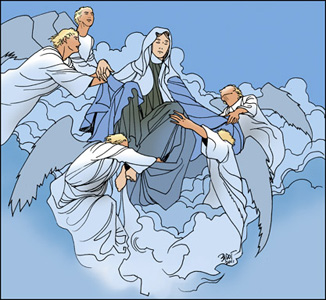
The end of life for the Virgin was glorious and immediate Life, i.e. that the Lord sent his angels to raise her, body and soul, to the glory of heaven. There are dogmatic foundations to this event: she who carried the Living could not know death, and she who had not been desecrated in her humanity could not know the desecration of the sepulcher. In addition Mary was like Eve before the fault. Preserved from the fault, the Virgin Mary had to be preserved also from the consequences, i.e. the corruption of death. By the Virgin’s Assumption, the Lord teaches us believers a truth which encourages us to believe in the resurrection of the body and the reward of everlasting and blessed life for the righteous. It is also so that we believe that it is in heaven that is found the heart of the Mother of men, beating with an anxious love for us all, righteous and sinners, eager to have us all by her side in the blessed homeland, for eternity.
The first mention of a feast day celebrating Mary’s death and glorification dates from the fifth century, in Gethsemane’s Marian sanctuary * This is by no means to say that this observance did not begin before the fifth century.. In the sixth century, the feast day of August 15 is unanimously accepted in Jerusalem and spreads to all the Byzantine Empire by edict of the Emperor, under the term of “Dormition” or “Repose” * Among all the Virgin’s feast days, Francis seems to have preferred the Assumption. Usually he prepared for it by a special fast of 40 days. It is without a doubt him we can thank for the lifting of abstinence, granted to « brothers and sisters of Penitence » on this day, just like on the « more important feast days », each time that this solemn occasion falls on a fasting day specified by their rule. For on that day, everything should give way to the joy of the honor given to Mary.. Indeed the first texts hesitate between the word Resurrection and Assumption. Ultimately, our sovereign Pontiff, Pope Pius XII, proclaims in 1950 the dogma of the Assumption of the Blessed Virgin Mary: “…the Immaculate Virgin, from the very beginning free from the taint of original sin, after finishing the course of her life on earth, was taken up in body and soul to heavenly glory and exalted by the Lord as Queen of the universe, so as thus to be entirely in compliance with her son, Lord of lords, victorious over sin and death.”
FRANCIS’ VERY SPECIAL LOVE FOR THE VIRGIN MARY
All of the biographies of Francis attest to the ardent and even extraordinary veneration he held in regard to Mary. Francis, a simple man, i.e. without recourse to books of science, is introduced to the heart of the mysteries of Mary through prayer and meditation. We should not expect to find on the part of Francis a clearly formulated doctrinal Marian exposé in the style of a theological treatise, and even less an exhaustive or even systematic study of the problems. Even so, Francis understood the Virgin’s eminent place in God’s plan of salvation. His words and writings give us the fruits of his prayer in a spiritual form so personal, so original and so unique that still today, these texts deserve a very special attention from us. * Most if not all of the lines which follow are extracted from the work edited by Editions Franciscaines (Franciscan Editions) 1958, Thèmes spirituels (Spiritual Themes), P. Kajetan Esser, ofm, pp. 149 à 178.
Mary and Christ
« He loved the Mother of Jesus Christ with an inexpressible love, for it was she who gave us as brother the Lord of all majesty” (2 C 198), “and through her we have obtained loving mercy” (Lm 9:3). These simple words from his biographies show us the deepest foundation of Francis’ veneration for Mary.
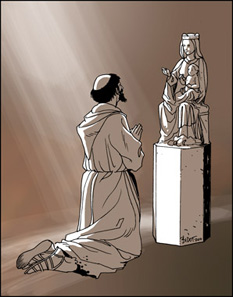 The Incarnation of the Son of God was the basis for all his religious life, and all his life he steadfastly tried to follow in every way the Word made flesh. And so, as is normal, he owed a grateful love to this unique woman who brought God within reach of our poor human condition, but who even more “gave us as brother the Lord of all majesty.” * These words show precisely that Saint Francis marks a culmination and a shift in the piety of the Middle Age Church. Following all the previous devotion, he still sees in Christ the « Dominus majestatis » (the Lord of all majesty), the Master who dominates all creation, as is represented in the “majestas Domini” by ancient art and that of the high Middle Ages. But Francis also knows– and this is what connects him to the new style of Christocentric piety – that from the Gospel (Mt 12:50 and 25:40-45), the Son of God has become through his Incarnation, the Brother of all the redeemed (1 Reg 22). Mary’s divine motherhood enables her the possibility to bring together both aspects. Thus the close collaboration of Mary in the work of our Redemption : we also owe her for God’s grace.
The Incarnation of the Son of God was the basis for all his religious life, and all his life he steadfastly tried to follow in every way the Word made flesh. And so, as is normal, he owed a grateful love to this unique woman who brought God within reach of our poor human condition, but who even more “gave us as brother the Lord of all majesty.” * These words show precisely that Saint Francis marks a culmination and a shift in the piety of the Middle Age Church. Following all the previous devotion, he still sees in Christ the « Dominus majestatis » (the Lord of all majesty), the Master who dominates all creation, as is represented in the “majestas Domini” by ancient art and that of the high Middle Ages. But Francis also knows– and this is what connects him to the new style of Christocentric piety – that from the Gospel (Mt 12:50 and 25:40-45), the Son of God has become through his Incarnation, the Brother of all the redeemed (1 Reg 22). Mary’s divine motherhood enables her the possibility to bring together both aspects. Thus the close collaboration of Mary in the work of our Redemption : we also owe her for God’s grace.
The Incarnation of the Son of man by Mary elicits thanksgiving from Francis. With joy, he thanks and praises the heavenly Father for having granted to Mary the grace of divine motherhood. He sees in this grace – and in it alone – the first and most important reason for her praise and veneration: “Listen, my brothers. The Blessed Virgin Mary is so honored – and it is just – because she carried Christ in her very blessed womb…” (3 Let 21). It is important to remember that in Francis’ time, the Cathar heresy, by virtue of its dualist principal, denies the Incarnation of the Son of God; at the same time it reduces Mary’s participation in the work of Salvation to nonexistent. And so that his Marian devotion might clearly express his thoughts against these errors, Francis never ceases to highlight, without equivocation, the Virgin’s real motherhood: “This Verb of the Father, so worthy, so holy and glorious, the most high Father by announcing the coming, through his holy archangel Gabriel, to the holy and glorious Virgin Mary, from whose womb the Verb truly receives the flesh of our fragile humanity” (1 Let 4). In this “Greeting to the Mother of God”, Francis glorifies Mary’s authentic divine motherhood through a true litany. He proclaims it in concrete and figurative terms: “God’s Palace and Tabernacle”, “God’s House and Clothing”, “God’s Servant and Mother” * Brother W. Lampen, ofm, assembled all the names with which Francis honors Mary (De S. Francisci cultu Angelorum et Sanctorum, dans Arch. Franc. Hist 20 (1927), p. 12), and comes to the surprising conclusion that he never used one twice. He sees there a sign of Saint Francis’ poetic originality and inventive love.. These expressions distinctly show his concern to safeguard in the Christianity of the time, threatened by Catharism, the authentic image of Mary.
Let us now try to identify what, in this first aspect of Francis’ Marian devotion, will remain valid for all time. We should begin by stressing: Francis never sees Mary in isolation, detached from this mystery of divine motherhood which alone is the basis for her role in Christianity. The importance for Saint Francis, in his veneration towards Mary, is to specifically highlight the mystery of Christ Man-God. It can be said moreover that by emphasizing to this degree Mary’s physical maternity, Francis maintained in Christian life, in its devotion and asceticism, a sharp, dynamic and lively image of the Jesus of history, forever inseparable from the Lord resurrected and lifted up to heaven, as the Scriptures testify. Which is why, in Francis’ Marian devotion, there is an absence of all abstraction, all conceptual science. He always starts from the concrete, the palpable, the historical fact, and so from divine revelation; because this latter manifests itself in the tangible and actual events from the history of Salvation. It is exactly there that Saint Francis’ Marian devotion should mark, in a lively and lasting way, all the future of the Church.
Mary and the Holy Trinity
Francis is very clear that in Mary’s life, everything comes from God. Never does Francis glorify Mary without glorifying at the same time God one and triune. Never does Francis see and contemplate Mary alone, neither for herself, nor even uniquely in her particular relationship with Christ. He always avoids that pitfall so as to consider her in her concrete and living relationships with the Trinity: “Hail, Mary, holy Lady, queen, holy Mother of God, you are the Virgin become Church; chosen by the very holy Father of Heaven, consecrated by him as a temple with his beloved Son and the Holy Spirit Paraclete, You who were and remain full of grace and He who is all good” (SBV 1-3). Once more, as we see, all Mary’s characteristics which Francis praises bring us to the central mystery of his life: the divine motherhood; but this motherhood is, in the humble Virgin, the work of God-Trinity. Even her perpetual virginity is wholly centered on divine motherhood. Virginity makes Mary the “pure vase” where God can pour out the fullness of his grace to achieve in her the great mystery of the Incarnation. Virginity is not then a value in itself * Would we not risk, indeed, confusing virginity and sterility if we made virginity a value in itself ? but is pure receptivity for divine action which fills it with a humanly incomprehensible fertility. That way “she is completely consecrated by God with his beloved and very holy Son and the Holy Spirit Paraclete”. God-Trinity’s action never ceases nurturing this fertility: “You who were and remain full of grace and everything good”.
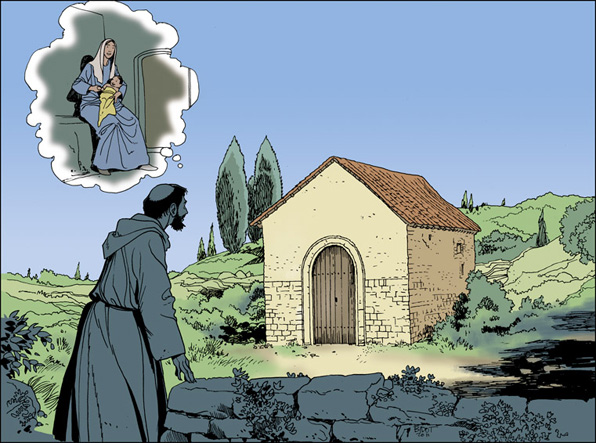
Francis had an antiphon that he had composed recited at each of the hours of the Divine Office. It expresses more clearly yet the living relationship between Mary and the Trinity: “Holy Virgin Mary, no one is like You among the women of this world: daughter and servant of the most high King, the heavenly Father, mother of our very holy Lord Jesus Christ, spouse of the Holy Spirit.” Here again, it is the work of divine grace in Mary which is exalted with the appropriate descriptions. The first two are clear and do not pose any problems: we find them already often used in the earlier tradition of the Church. But we need to consider at greater length the third attribute: “spouse of the Holy Spirit”, so widely used today * W. Lampen studied the work of the Jesuit C. Passagli « De immaculato Deiparae semper Virginis conceptu » (vol. I, Naples 1855), where we find a list of six hundred titles given to Mary by the ecclesiastical authors from the East and the West. Yet he did not find the attribute in question. He thus supposes, justly, that Saint Francis was the first to use it.. Francis penetrates, into their deepest meanings, all the assertions about Mary from the Gospels. Then, in his prayer, he translates clearly what in the message of the Angel Gabriel is said in veiled language. Mary becomes Mother through the workings of the Holy Spirit. Because, Virgin, she is completely open to this action or, as Saint Francis said, « in all purity » she became, as wife of the Holy Spirit, “Mother of the Son”. Here especially, the depth of the intuition into the heart of the mystery appears to us in Saint Francis as the fruit of meditation. Indeed, in the words of Celano, the Lord’s humility in his Incarnation seized him to the point that he could hardly think of anything else. He never tired of reflecting on this mystery. He could spend whole nights in prayer, in “praise of God and of the glorious Virgin, his Mother” (1 C 24).
Mary and God’s plan
Because she is Mother of Jesus, Francis likes to call upon Mary as “Mother of all bounty” (LM 2:8). That is why he settles near the Portiuncula sanctuary dedicated to the Mother of God; for he expected everything from her bounty: “He placed in her, after Christ, a very special trust” (1 C 21). It is there, in the Portiuncula sanctuary, that according to the expression of Saint Bonaventure, he conceived and brought forth the Spirit of evangelical truth through the merits of the Mother of mercy. The holy Doctor highlights this mystic assertion by bringing it back to the mystery of the Incarnation, where Mary “conceived the Verb full of grace and truth” (Lm 3:1, Lm 7:3). Never before shall we have entered more profoundly into Saint Francis’ love and veneration for Mary. But his Marian devotion does not confine itself to ardent forms of prayer and hymns of praise; it leads to his constant concern to appropriate in every way Mary’s attitude towards the Word of God, the Verb of God. Everything begins with conception: following Mary’s example, man must receive in himself the Word of God, welcome it with an obedient faith, be totally penetrated by it.
 Then, this conception must result in birth: again like Mary, man must, in the submission of his faith, engender the Word of God, give it form and life. Saint Bonaventure notes a sort of parallel between the mystery of the Incarnation of the Verb in Mary and in Francis. He could not have said it any better than with the happy and penetrating language he used to express the Marian orientation of Poverello’s evangelical life. Saint Bonaventure does not introduce foreign theological concepts into his biography of his Order’s founder. It is enough to reread Francis’ letter to all the world’s faithful: he unveils there his thinking with rare abundance. In the first lines (1 Let 4-5 (second edition)), he describes the divine Verb’s birth from the womb of the glorious and holy Virgin Mary. But it is not in Mary alone that this divine birth takes place; it seeks to reproduce itself mystically in the heart of the faithful. Further on in the letter, Francis interprets this mystery in his own language, making a striking synthesis: “We are mothers for him, when we carry him with love, loyalty and a pure conscience, in our heart and our body, and we give birth to him through our good actions, which should be a light and an example to others” (1 Let 53).
It might seem at the outset that Francis is simply exposing a rather ascetic view of this mystery. But in the same context, we find another affirmation, intimately linked to that which concerns the spiritual maternity: “We are his spouses when, through the Holy Spirit, the faithful soul is united to Jesus Christ.” The mystery of the spiritual maternity melts into and takes root in the parallel mystery of nuptial intimacy created by the Holy Spirit between Christ and the faithful soul * Jesus teaches us this forcefully : “Here are my mother and my brothers. Anyone who does the will of my Father in heaven is my brother and sister and mother.” Mt 12 :49-50.. This maternity does not then develop uniquely through our own efforts, through our ascetic living; it is also and above all a supernatural gift of love from God in the Holy Spirit.
Then, this conception must result in birth: again like Mary, man must, in the submission of his faith, engender the Word of God, give it form and life. Saint Bonaventure notes a sort of parallel between the mystery of the Incarnation of the Verb in Mary and in Francis. He could not have said it any better than with the happy and penetrating language he used to express the Marian orientation of Poverello’s evangelical life. Saint Bonaventure does not introduce foreign theological concepts into his biography of his Order’s founder. It is enough to reread Francis’ letter to all the world’s faithful: he unveils there his thinking with rare abundance. In the first lines (1 Let 4-5 (second edition)), he describes the divine Verb’s birth from the womb of the glorious and holy Virgin Mary. But it is not in Mary alone that this divine birth takes place; it seeks to reproduce itself mystically in the heart of the faithful. Further on in the letter, Francis interprets this mystery in his own language, making a striking synthesis: “We are mothers for him, when we carry him with love, loyalty and a pure conscience, in our heart and our body, and we give birth to him through our good actions, which should be a light and an example to others” (1 Let 53).
It might seem at the outset that Francis is simply exposing a rather ascetic view of this mystery. But in the same context, we find another affirmation, intimately linked to that which concerns the spiritual maternity: “We are his spouses when, through the Holy Spirit, the faithful soul is united to Jesus Christ.” The mystery of the spiritual maternity melts into and takes root in the parallel mystery of nuptial intimacy created by the Holy Spirit between Christ and the faithful soul * Jesus teaches us this forcefully : “Here are my mother and my brothers. Anyone who does the will of my Father in heaven is my brother and sister and mother.” Mt 12 :49-50.. This maternity does not then develop uniquely through our own efforts, through our ascetic living; it is also and above all a supernatural gift of love from God in the Holy Spirit.
The birth of Christ in the heart of the faithful is only one aspect of this maternity. Indeed, for Francis, by this Christian life, i.e. by the “practice of good, light and example” towards our neighbor, we give birth to Christ in others. Here, the maternal function of a personal Christian life results in the whole Church giving birth to life. Francis often spoke of this maternal function of the faithful in the Church. That is how he applies “to his simple and unlettered brothers” these words from Scripture: “the barren woman bears sevenfold” (1 Sam 2:5), and he makes the following commentary: “The barren woman is the poor little brother who does not have as mission to give birth to children for the Church; but we will see on judgment day that he has become the mother of many sons, for the Judge will attribute to him for his glory all those he converted to Christ through his prayers that no one sees” (2 C 164).
What has come true in Mary’s motherhood for the salvation of the world will still and always continue by the supernatural action of the Holy Spirit in the hearts of the faithful. Is it not, in fact, the same mystery of the Church, in which the faithful participate? This grace that Francis contemplates in Mary, he knows that he participates in it. This same work of grace, he knows that it will have to come about through him and his in the Church. Mother of Christ, that is who Mary is to him first and foremost; that is why he loves her with an unspeakable love. Divine motherhood, that is the mystery that his eyes discern in the faithful “who hear the word of God and put it into practice” (Lk 8:21), and thus take part in the maternal function of our Mother Church. Having come this far, we can summarize Francis’ Marian ideal as “Live in the Church like Mary lived.”
THE VIRGIN MARY, HUMBLE SERVANT OF THE LORD
Article 9.
Francis had a special love for the Virgin Mary, the humble servant of the Lord, always open to his every word and call; he wanted her as the protector and advocate of his family * 2 C 198.. Secular Franciscans should express their ardent love for her by imitating her complete selflessness and through earnest and confident prayer.
The last part of this chapter will seek to avoid repetition in regard to all that has already been presented. Since the aspect of the Virgin’s acquiescence to the Lord’s will was strongly developed earlier in this chapter (see notably the fiat of the Annunciation), and without nonetheless forgetting it, we will consider firstly one of the concrete forms of Francis’ Marian devotion, namely the Virgin’s poverty. We will find that Francis’ Marian devotion is not like a foreign and isolated object in his life. Externally and internally, it becomes one, in an indissoluble unity, with his ideal of imitating Christ, especially regarding very great poverty. We will then see why Francis chose the Virgin Mary as his family’s protector and advocate. Lastly, we will delve more deeply into how to testify to Mary, personally and communally, our love for her.
Mary, the poor Lady
According to Thomas of Celano, the Lord’s humility in his Incarnation struck Francis to the point that he could hardly think of anything else (1 C 84). He never tired of reflecting on this mystery. This action of divine love, welcomed by Mary with a heart full of faith, with an unreserved yes, elevated, in Francis’ eyes, the Mother of God above all creatures. And so he sang “Holy Lady, that very holy Queen”, as well as “Lady of the world” (LM 2:8). But Francis stresses even more strongly another noble title for Mary, fruit of the first: she is for him the “poor Lady” (2 C 83). But here again, this title does not have for him an isolated autonomous value. He sees in Mary’s poverty a concrete response to that of Christ. It is a sign of total and consensual communion of Mary to the destiny of her Son. In this redeeming poverty of Christ, Mary and Jesus’ disciples played their part ; in his turn, Francis wants to participate with all those who wish to follow him.
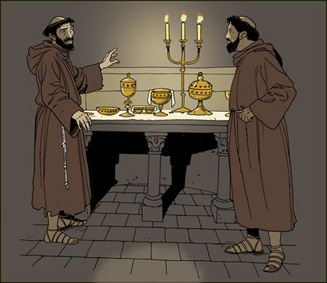 And so, when he demands from his brothers a life of poverty and begging, he reminds them of Christ’s example, “which was poor and without shelter, which lived on charity, he and the blessed Virgin and his disciples” (1 Reg 9:5). Moreover he called poverty the queen of all virtues, because it shone with such a dazzling light from the King of kings and his Mother, our Queen (LM 7:1).
And so, when he demands from his brothers a life of poverty and begging, he reminds them of Christ’s example, “which was poor and without shelter, which lived on charity, he and the blessed Virgin and his disciples” (1 Reg 9:5). Moreover he called poverty the queen of all virtues, because it shone with such a dazzling light from the King of kings and his Mother, our Queen (LM 7:1).
Francis saw in Mary someone who loves the evangelical life of poverty above all else. In his opinion, she valued such a life more than any exterior act of veneration. One day, Brother Peter of Catania, Vicar of the Order, seeing the multitude of foreign brothers pouring into Saint Mary of the Portiuncula, finds it very difficult to feed all these people as the alms they have received are not sufficient. So he says to Francis, “Father, I do not know what to do. From all sides people are coming here in droves, and I do not have enough to meet the demand. Give me, I pray you, permission to receive and put in reserve a part of the novices’ assets, and I will be able to take from it when-ever needed.” “My very dear brother,” responds Francis, “far may it be from us, this misguided pity: in favor of a man, you would sin against the Gospel!” “What should I do?”, replies Brother Peter of Catania. And Francis answers, “If you cannot manage in any other way, strip the altar to the Virgin and sell the dishes. Believe me, she will be much happier seeing her Son’s Gospel respected and her bare altar than her altar ornate and her Son scorned. The Lord will indeed send someone to give back to his Mother that which she lent us.” (2 C 67) Such a narrative shows us how seriously Francis took the imitation of Mary’s poverty, and how this poverty became integrated into a life completely in compliance with the Gospel.
Mary, protector of the Order
Saint Bonaventure tells us that Francis, in the first years after his conversion, lived voluntarily at the Portiuncula, a church dedicated to the Virgin Mother of God, and that in his prayer he urgently begged her to be for him an “advocate” full of clemency (LM 3 1). He did not want her for himself alone, but also for his brothers, as Thomas of Celano tells us so well: “But we have good reason for being so joyous, for he wanted to choose her as the Patroness of the Order * Advocata, i.e. both protectress and advocate, who fosters and protects. This invocation is found in the Salve Regina (XIth century). so that she could take us under her wings, could coddle and protect us until the end, the brothers that he himself would one day have to leave” (2 C 198). For Francis and the Brothers Minor, who had renounced all goods in this world, this term of advocate could only have a spiritual meaning * At the time of Francis and before, certain Orders who were owners of much wealth called upon a lawyer to represent them in the secular courts. The lawyer had to protect them and if necessary defend them against any outside violence and usurpation. It proved to be, more than once throughout the ages, an opportunity of abuse. That is why the Cistercians renounced in principle the use of lawyers (although they sometimes came to regret it) and chose Mary as advocate for their Order.. Mary had to represent the Brothers in front of the Lord, take care of them and protect them in all the vicissitudes and crises of their existence. To the Order’s protection was added, for Francis, Mary’s intercession to God the Trinity. This intercession is expressed as much at the level of thanksgiving as that of the forgiveness of sins.
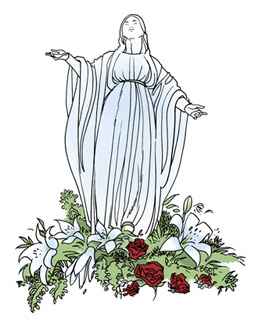 Francis thus addresses her as “the glorious, always Virgin and very blessed holy Mary”, to humbly implore her, in the presence of all the angels and saints, to help him and all the Brothers Minor, to thank “God, the Eternal and Holy”, “as it pleases him” (1 Reg 23:6), for his immense grace, his work of Salvation. At the head of all the triumphant Church, that she deign to present in our name this thanksgiving to the eternal Trinity.
Francis thus addresses her as “the glorious, always Virgin and very blessed holy Mary”, to humbly implore her, in the presence of all the angels and saints, to help him and all the Brothers Minor, to thank “God, the Eternal and Holy”, “as it pleases him” (1 Reg 23:6), for his immense grace, his work of Salvation. At the head of all the triumphant Church, that she deign to present in our name this thanksgiving to the eternal Trinity.
Francis also confesses all his sins, especially his omissions in the evangelical life demanded by the Rule and his infidelities in divine praise, to “the blessed Mary always Virgin”. Let us note that he confesses to the Virgin Mary after having confessed to God the Trinity as well as all the other saints. He makes this confession for “he did not always say the service according to the Rule: either because of negligence, sickness, or because he was ignorant and uncultured” (3 Let 39). It is especially concerning his omissions towards God that full of trust, he addresses his “advocate” so that she take him under her protection. This request is expressed with great depth in the paraphrased Our Father: “…forgive us our debts, through your indescribable mercy, by virtue of your beloved Son’s Passion, our Lord Jesus Christ, by the merits and powerful intercession of the very blessed Virgin Mary and all of the chosen.”
Let us testify to Mary an ardent love
Article 9 of our Rule invites us to testify to the Virgin Mary an ardent love. Our Rule, both concise, practical and open, orients us in two concrete ways: firstly by imitating Mary’s total availability towards the Lord; then by an earnest and confiding prayer to the Virgin Mary.
Mary’s total availability is certainly summed up best in her response to God the Trinity’s spokesperson on the day of the Annunciation: "Behold, I am the handmaid of the Lord. May it be done to me according to your word." By her yes, she physically became the Mother of the Lord. But this biological fact is theological reality, because it is the realization of the most profound spiritual content of the covenant that God made with Israel. This is what the evangelist Luke brings marvelously to light in Elizabeth’s declaration: “Blessed are you who believed” (Lk 1:45) and in Christ’s response to the woman’s observation: “Blessed are those who hear the word of God and observe it” (Lk 11:27). Who, better than Mary, believed the Word and put it into practice? We find in Mary’s compliance our great and serious intentions: her Son’s will, that God’s name be glorified, that his kingdom come and that his will be done on earth as it is in heaven.
Mary’s veneration is the surest and shortest way for us to get closer to Christ in a concrete way. By meditating on Mary’s life in all its phases, we learn what it is to live for Christ and with Christ, daily, in a proximity that presents no exaltation, but knows a perfect interior closeness. By contemplating Mary’s existence, we also place ourselves in the obscurity which is imposed on our faith ; however, we learn how to be constantly ready, when Jesus suddenly demands something from us. The most often said Marian prayers always lead us to this physical closeness with the Lord and with all the mystery of Redemption. Let us show three of these prayers.
The Ave Maria is, excepting the final request, only made up of words from the Holy Scripture: the angel’s greeting (hail, full of grace, the Lord is with you) and right after Elizabeth’s wonderful words, which at the same time show us true Marian veneration (blessed are you among women, and blessed is the fruit of your womb). The final request which, along with the Council of Ephesus gave Mary the Christological title “Mother of God”, formulates as simply as possible the Christian sinner’s intention in the Church: to ask for intercession now and at the hour of our death which decides everything.
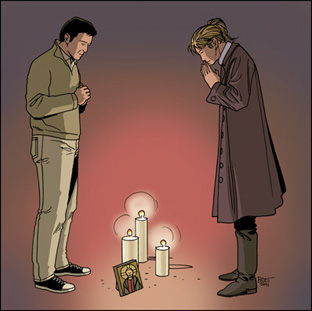 Likewise, the Angelus does not go beyond that which is found in the Bible, the three brief Christocentric phrases: the announcement of the Incarnation, the Virgin’s consent and the fulfillment of the Incarnation itself. The three added Aves let us rest near the human creature in whom was realized the miracle of the Incarnation, and in that way enter into, so to speak, the radiance of the miracle. All Christians who so pray know that the Incarnation of the Verb also concerns them directly, that it must also be fulfilled in them, if they want to bear the name of Christian.
Likewise, the Angelus does not go beyond that which is found in the Bible, the three brief Christocentric phrases: the announcement of the Incarnation, the Virgin’s consent and the fulfillment of the Incarnation itself. The three added Aves let us rest near the human creature in whom was realized the miracle of the Incarnation, and in that way enter into, so to speak, the radiance of the miracle. All Christians who so pray know that the Incarnation of the Verb also concerns them directly, that it must also be fulfilled in them, if they want to bear the name of Christian.
Finally, the Rosary. Certainly, this is a prayer which is not always easy and does not interest everyone in the same way. This mode of prayer covers all Salvation’s history, the actual representation of the mysteries of Jesus’ life: his youth, the end of his public life in the Passion, his resurrection and completion, in which he also introduces Mary as the archetype of the Church: representation of Christ’s prayer to the Father, and finally the always new glorification of the Trinity; the whole introduced by the complete profession of faith. In the succession of Ave Marias an almost infinite space in the world of prayer, a space which can be followed in all directions, opens for the contemplative person in prayer; but, so as not to become lost, Mary is given as the supporting point. In her, the mystery of the Trinity is revealed for the first time. She then accompanies the incarnated God from the cradle to Calvary and beyond, to glorified life; Mary, like no other, is associated in Jesus’ progression until her physical Assumption in the sky which is given to her, first among believers who must one day follow her. It is also a prayer composed of texts and purely biblical aspects, and which, for this reason, has been recommended to Christians throughout the centuries, in communal as well as personal prayer.
QUESTIONS
What did I retain?
- Through God’s exceptional grace, and without any merit on her part, Mary was born without sin, the Immaculate Conception. There are, nevertheless, merits which accrue to the Virgin Herself. Indeed, all her earthly life, the Virgin Mary lived in a way which the Lord delighted in, in an attitude that we are invited to meditate and imitate. What is this attitude?
- The secret of the saints is to go towards Jesus by way of Mary, for it is not possible to persevere in Christ if grace is not strengthened by the help of Mary, full of grace. Francis, who chose the Virgin as protector and advocate for his family, understood the Virgin’s eminent place in God’s plan of salvation. Can I remember how Francis sees Mary in God’s plan of salvation?
- Francis one day tells Peter of Catania to go strip the altar of the holy Virgin so as to meet the material needs of the brothers coming to the Portiuncula. What reason(s) does he give to justify such an act?
For further reflection
- The Virgin Mary is truly she who carried in her the Lord. The Covenant of the Ark in the Old Testament, which could at that time pass for a definitive covenant between God and men, foreshadowed Mary, the virginal Ark of the new covenant, more precious than that which contained manna and the Tablets of the Law. This chapter on the Virgin Mary, Mother of Jesus, began by Toby’s magnificent canticle (Tb 13:11-14) which seemed addressed to the city of Jerusalem. Can I reread this canticle showing how Toby’s prediction, in each line, indeed concerns the Virgin Mary?
- Our Rule invites Franciscan laymen to testify to Mary an ardent love by imitating her total availability. In the human condition which is mine, how can I imitate the Virgin Mary, humble servant of the Lord, She who was always open to his word and his calls?
- Our Rule invites Franciscan laymen to testify to Mary an ardent love through earnest and confiding prayer. Do I know how to take the time to be for the Lord by way of Mary? In the negative, what good attitude can I adopt from today to pray, earnestly and confidingly, the Blessed Mary always Virgin?


